When I was in high school there were the best little thrift stores dotted all over town, very often in shunned neighborhoods. Aided by a ripped out phonebook yellow page, we would seek to find every single shadowy store, foraging for the fabulous lost clothes of the 1920s-60s. I had always thought the years had been unkind to those older buildings, its people and the well-made treasures deposited within. A mislaid museum. I told myself our frequent pilgrimages were a rescue mission and now know, more than ever, that to be true. I learned so much in those days. Only older ladies appeared to direct these second hand stores, customarily perched, sometimes in pairs, behind their glass counters, a thin hint of an AM radio wafting from an unseen corner. But very often a tiny bell on the front door was the only sound one could hope to hear during this cultural study. It was in this fervent exploration that I came to know the perfectly cluttered thrift shop at 24th and Farnam. My friends, just now, I had to retrace for the shop’s name, as it has been far too long since I passed through the once familiar doorway: Omaha Education Association Thrift Store or OEA Thrift, as we came to know her.
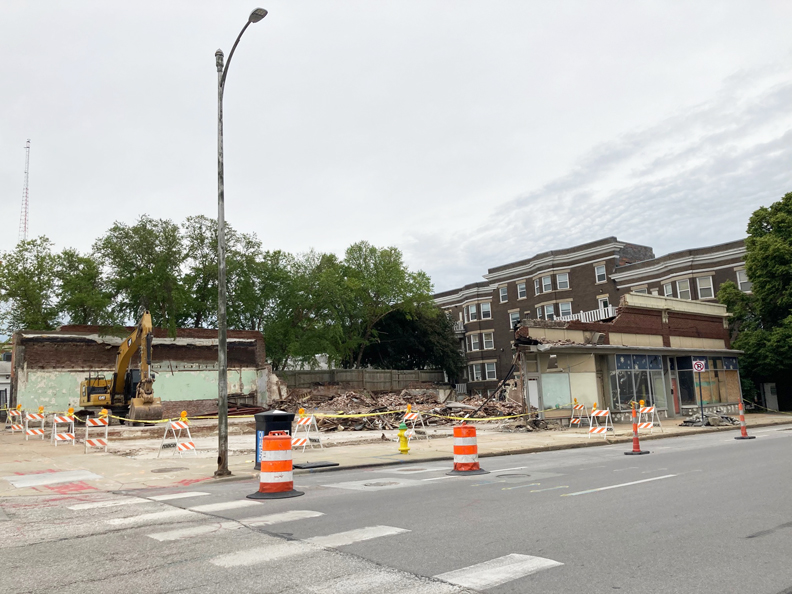
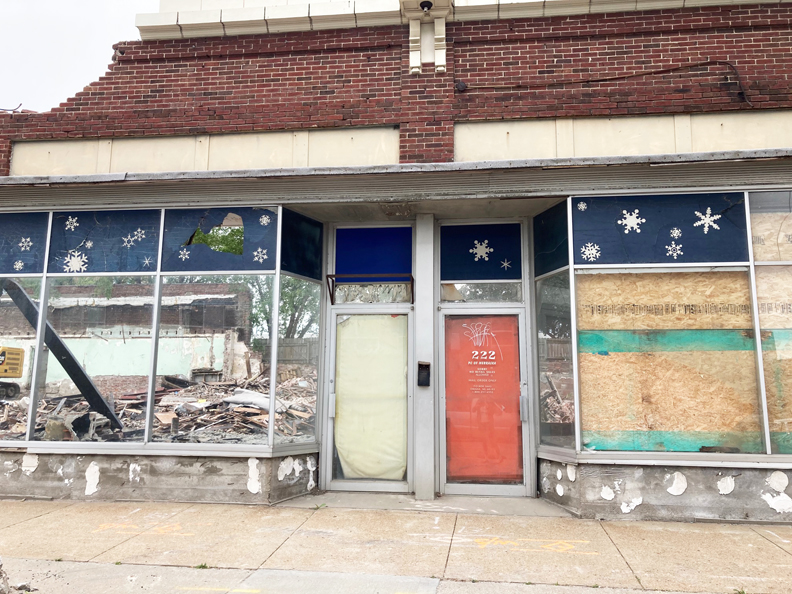
Photos from May 30, 2021.
Accommodating the once OEA Thrift and many other thriving businesses in its prime-of-life, the charming building on the northwest corner of 24th and Farnam would later be assigned the postal name of 2406 Farnam Street. This wasn’t always her label—in fact, all of her doorways carried their own addresses. 2406 Farnam had been boarded up for at least five years, I think deserted before that. 2406 Farnam was razed in late May of 2021. The property owners group of the Even Hotel, at 2220 Farnam Street, across the street, have something in store for this corner.
In the 1980s a bus fare, Vespa ride or a long walk (after someone’s mother shuttled us to a calculable, remote location) landed us in the western fringe of downtown—a fascinating neighborhood later named Park East. It was there that we discovered the haven of OEA Thrift, with some of the best vintage I had found in town. Every color of 1940-50s ladies’ gloves! I didn’t know OEA Thrift had moved into that 220 South 24th Street location in 1969 but it had been in business since 1954—originally helping to raise money for the OEA Manor, a home for retired schoolteachers. Truth was, retired teachers volunteered their time to run the little store. Lodged in one of the northern bays on the 24th Street side, I perceived an air of cool intrinsic to OEA Thrift because of its tenancy in this enchanting brick building.
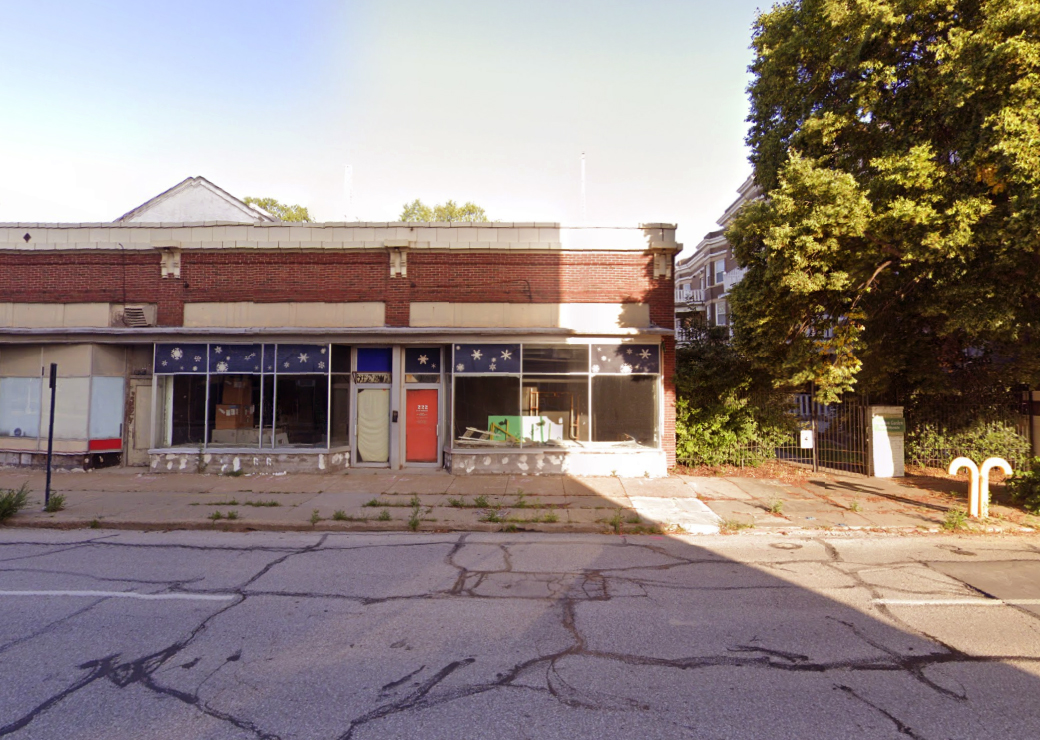
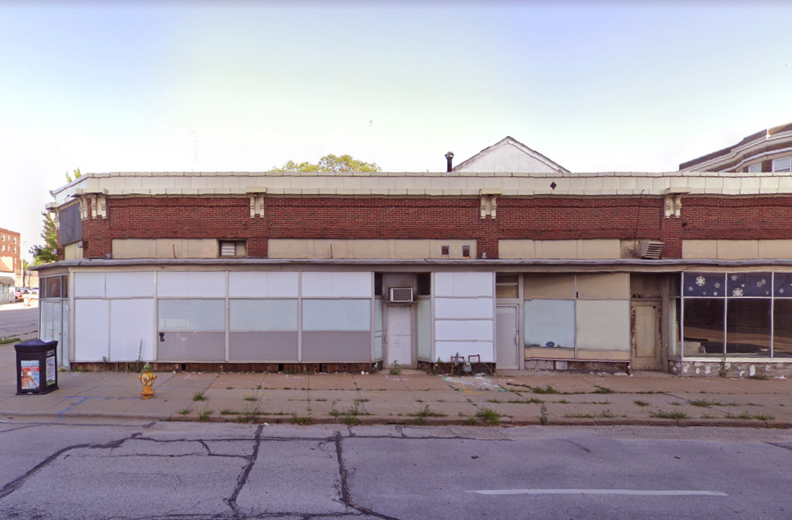
Still intact in 2019. This is the eastern elevation of the building at northwest corner of 24th and Farnam. Note the white gable roof peaking from the middle of the building. Did this little house up there once have glass skylights? I could see it providing a sunny atrium to one of the leased spaces.
Near to downtown, the building had special little architectural details, that now remind me of the Northrup Jones Company at 1615 Farnam and their Old English Inn location at 5004 Dodge. There was this mesmerizing band, like a slight lip of light tile that ran along the edge of the roof with deserted light fixtures. She was the rare one-story structure, just a part of what made her unusual for downtown, but the classic composition and refined touches told me the building was not thrown together on the cheap. Light and engaging, I thought the whole corner was an eye-pleasing, old time retail and service building with numerous bays opening onto both 24th and Farnam, a multitude of individual, inset doorways and great large paned windows—calculated long ago for public intrigue. The lined up stores had terrazzo floors and metal ceilings. It conjured visions of a ladies’ luncheonette, an ice cream parlor, a stationer. Surely a radio-repair shop had to have rented there at one time. Even back then I perceived her as quirky and already loved.
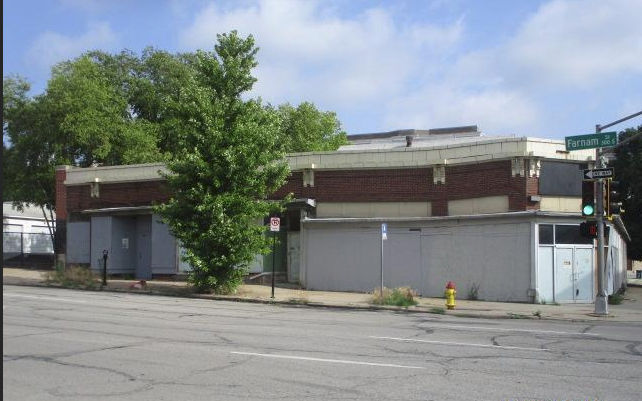
2020 image borrowed from the Douglas County Assessor’s site. Camera is facing north; building is seen across Farnam Street.
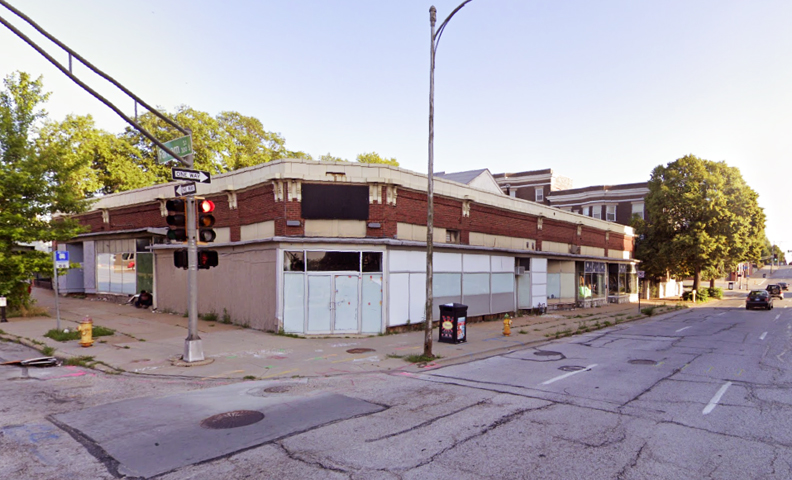
June of 2019.
In the 1980s the structure still had a welcoming presence and I do hate to breathe these words, but she was the authentic version of what modern day strip malls are reaching for, minus the franchises, ugly parking lot and marquee. Something about the way that corner, on the southern point of the building, angled toward the oncoming drivers of 24th and Farnam, was both entrancing and peculiar. It felt like those neighborhood corner bars and pharmacy entrances that I so love. The whole building, really, the whole surrounding area, intimated a marvelous movie set—one that had magically maintained its historic and architectural integrity. It was all there, preserved–but what I had assumed in high school was a historic area just waiting for its rightful script and dramatic close-up was already, shockingly, disparaged as the heart of the red light district.
For more on the Park East Neighborhood, check out my previous investigations: Mysteries of Omaha: 2561 Douglas Street and The Secret of the Muse Theater.
Thrifting
I let the moment linger. In those early to mid 80s we had the luxury to hunt alone, most certainly under dim lighting—the strange luminescence of a bubbling fluorescent tube over rows of simple racks, labeled only with handmade signs—such as “50 cents” or “$1.00.” These small environments very often were stagnate and sealed away from time–hot in the summer, sometimes with a oscillating fan circulating the stale smell of attic coffers. Oh to smell those rich relic emporiums again…Those were truly the golden years for vintage clothes, as thrifting was mostly looked down upon. There was little competition for the antiquated tchotchkes and pristine condition clothes straight from someone’s great auntie’s cedar closet. (As an aside Second Chance and Beauty and the Beast vintage clothing sections bolstered our foundation of thrift store basics into pure glamour with their exceptional inventory. I do miss those paradises!) I am known to be rather sensitive but I am not exaggerating when I put forth that these older mavens tending the thrift stock were, generally speaking, not impressed with our lot. Of course some were delightful but overall the sales, as I remember it, were rung up in rather begrudging manner, sometimes the wares withheld for reasons unacknowledged. Now, it is true, our crowd paraded about in a somewhat comical manner—so fantastically goofy that I believe that older generations, no doubt uninitiated, perhaps perceived a threatening or slovenly demeanor. Adorned in punk buttons and band t-shirts, flops, mohawks and back-combed blue-black hair, attired in little old lady dresses, ripped tights, mohair cardigans and combat boots, I assure you that we were a cordial, innocent band of teens. But even if one was to strip away that bare dignity, let’s be honest, we strange birds very often were the only paying customers that day or any day. One would think they’d be pleased to get these items into good homes. These jumble shops were mostly frequented by the senior female variety but occasionally there would be an aged gentleman rummaging in a far off bin. We were the other regulars, so to speak. Eye opening to realize, as an adult, that many of these dears were volunteers. So it is within this social context, detectives, that I share this little story.
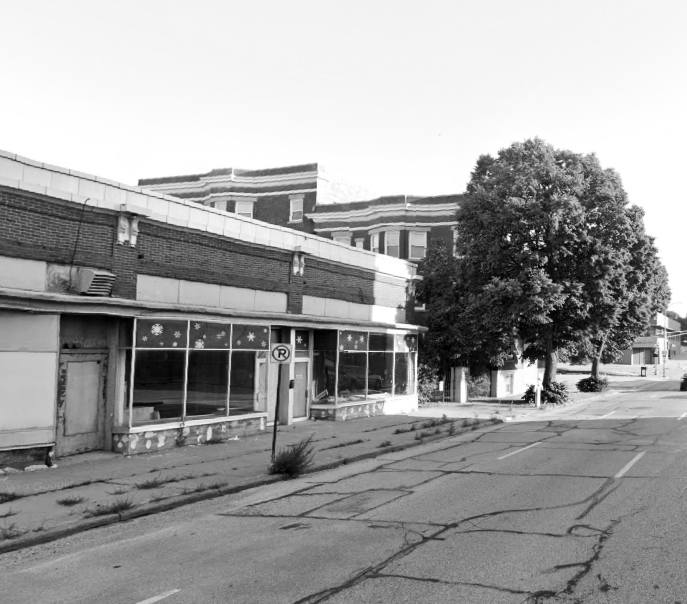
I would discover the Catholic priest “clerical” collar at the OEA Thrift one day and I had to have it. Was it behind the counter? Why was it even at a thrift store? I have often thought back on this mystery. In those days OEA had a wide array of Catholic medals, jewelry, holy water containers, scapulars, rosaries, trinkets, art, statues—what we lovingly call Catholic Kitsch in my house. Essential accoutrements for a young gothic girl. My Mary and Jesus statue and prayer card obsessions began in those days. I love all of it. Still do. Anywise, somehow I talked the nice lady behind the counter out of that sacred clerical collar, perhaps contending that I really didn’t see the likelihood of a proper priest wanting to buy his collar from a thrift store. (What a little snot.) Without enthusiasm, she acquiesced and I still remember her resentfully pressing the keys of the cash register. Surely a sigh or an agitated whispering was perceived. I might have squealed once outside. I wore that blessed accessory to many a show and teen basement party in the following years until I would meet Jacob Thiele, keyboardist of The Faint, more than a decade later. Fortuitously Jacob found an official priest’s black tab shirt at a thrift store and after little discussion, I decided he must own the white clerical collar. Those were good days and my eyes water up as I type to think of him in his priestly attire on stage all these years past.

Photo from Spring of 1986. My priest collar worn with my favorite early 1960s little boy’s pajama shirt with safety pin and cross. A fetching combination, don’t you think?
How Strange
By the time we came to know the 24th and Farnam building, that OEA Thrift was housed in, it was wedged into a densely built environment, elbowed in amongst structures presumably from the same time period. I have nostalgic yearnings for the mysteries once met in this neighborhood. 2406 Farnam was awkwardly crammed right next to the equally oddly positioned, south-facing Hamilton Garden Apartments. I couldn’t understand which building had been there first and who nudged who out? An older friend, a musician from the punk scene, lived in these apartments. I have mentioned elsewhere the memory of standing on his back stairwell during parties, watching the Ladies of the Night and their Johns and other strange goings-on for all to see in the apartment building’s parking lot at 24th and Douglas.
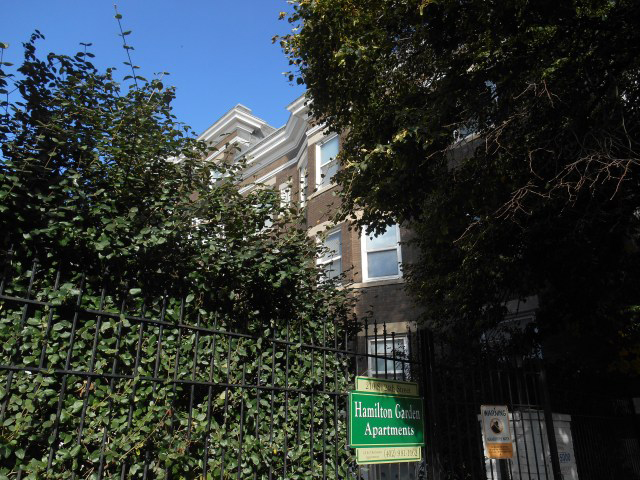
My friend’s old apartment building at the 210 S. 24th Street address was called the Hamilton Garden Apartments when I took this photo in 2016. They were sandwiched in with the 24th and Farnam Street building with only a slight view.
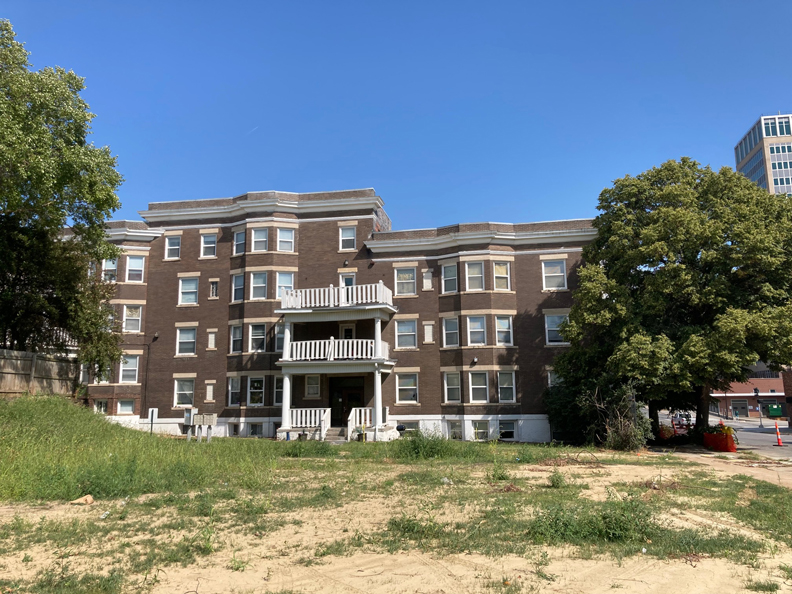
August 27, 2021. My camera is facing north. They had been perfectly hidden but here is how the Hamilton Apartments look today without the commercial building for cloaking.
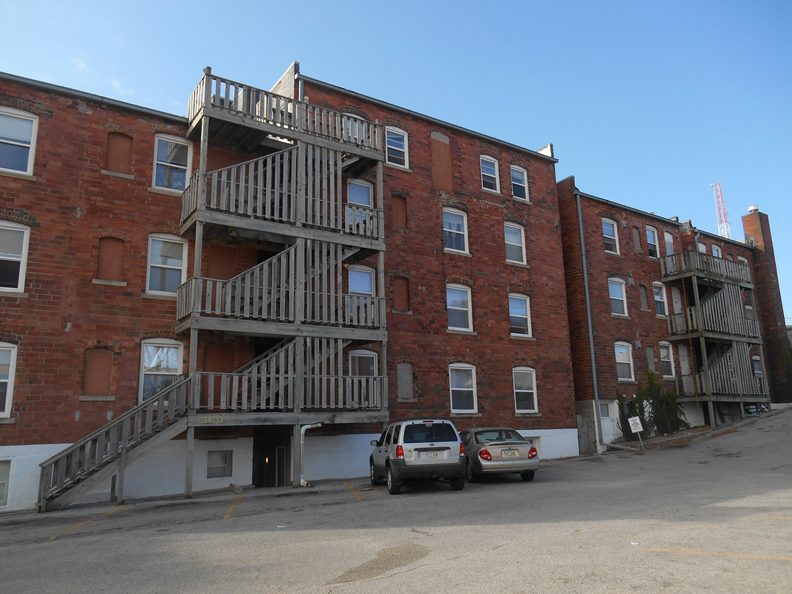
- Camera facing south. Backstairs of the Hamilton Apartments abutted the mystery parking lot on the southwest corner of 24th and Douglas. Many district antics back here. I honestly didn’t know that there was a formal, south facing entrance to this structure, as we always entered the apartment back here. By the way these stairs and landing are quite substantial compared to what used to be there. I always wondered what had previously stood where this parking lot was.
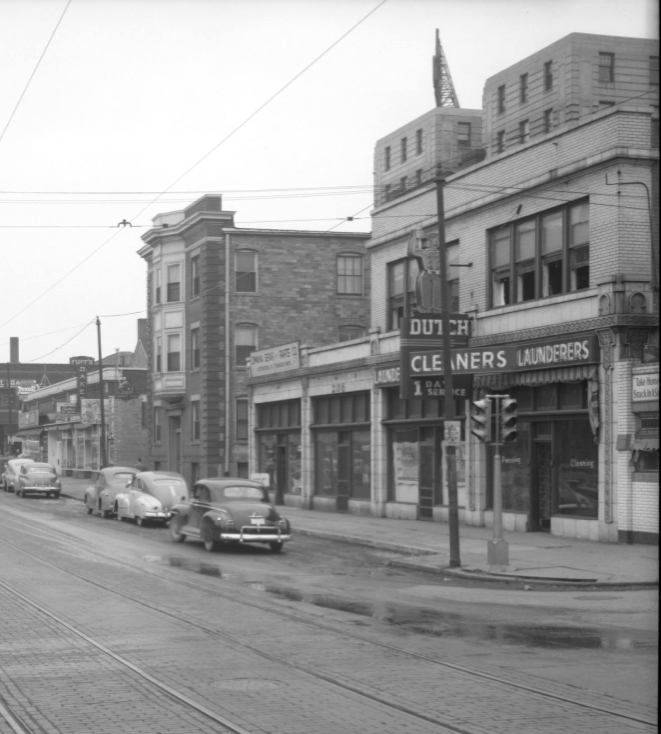
I just had to go looking. The Hamilton Garden Apartments parking lot (west of the F. O. E. Hall) was once a pretty cool building. Here it is in 1950. Looking south on 24th Street from Douglas Street. The Dutch Cleaners Laundry is on the right corner of 24th and Douglas. The Hamilton Apts is seen mid frame. The 24th and Farnam-OEA Thrift building is in the distance. Creator: Bostwick, Louis (1868-1943) and Frohardt, Homer (1885-1972). Publisher: The Durham Museum. Date: May of 1950.
The Darkly Lit Corner
Across the street from the OEA Thrift was the perplexing Delmar Hotel (northeast corner of 24thand Farnam at 219 South 24th), a shamed building of “hotel rooms” and sleeping rooms. I have a deep affection for this hotel; it was actually two buildings. Jim Jarmusch’s Mystery Train will forever remind me of the wild Delmar movements and leaves me wondering if Screamin’ Jay Hawkins possibly might have worked as night manager of the Delmar. That only would have made it cooler. The Delmar Hotel was snuggled in with a Delmar Café, south-facing (2240 Farnam) and the Delmar Bar, at times called Club Delmar (213 South 24th). The whole corner (both buildings) was later torn down and became a short-lived tent community for Occupy Omaha protestors, until they were moved along by the authorities. The Anant development group assessed this corner needed a hotel and by 2016 they had built their contemporary Even Hotel. This is a Very Omaha sequence of events.
I had no idea that the 2406 Farnam Street building would be torn down this spring. I knew the Siedliks had sold to Anant Enterprises in 2015, but my adoration for the building blinded me to the possibility that it, like the Delmar, would be razed. Back in 2016 I had begun an investigation into my magnetic Delmar Hotel. (I am still spinning away on that story.) At that time I was fortunate to interview a postal worker on his neighborhood beat. He tipped me off that there was (still is?) a tunnel beneath 24th Street that led from the Club Delmar to one of the operations in the 2406 Farnam Street building. He was confident that this passage was a remnant of the underground bookie-cigar-prohibition world. I will admit to you that a good part of my obsession with today’s investigation is that I had always dreamed I would get a chance to rummage about in the cobwebbed bowels of the 2406 Farnam Street building. I continue to accumulate clues.
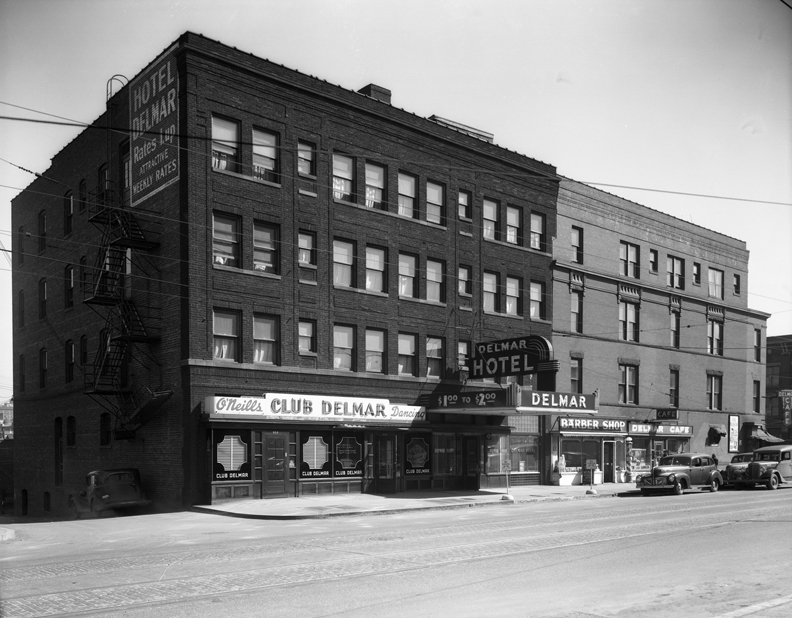
Delmar Hotel on the northeast corner of 24th and Farnam Street. Camera faces east. The Club Delmar and the Delmar Cafe occupy the bottom floors. Creator: Bostwick, Louis (1868-1943) and Frohardt, Homer (1885-1972). Publisher: The Durham Museum. Date: March of 1942.
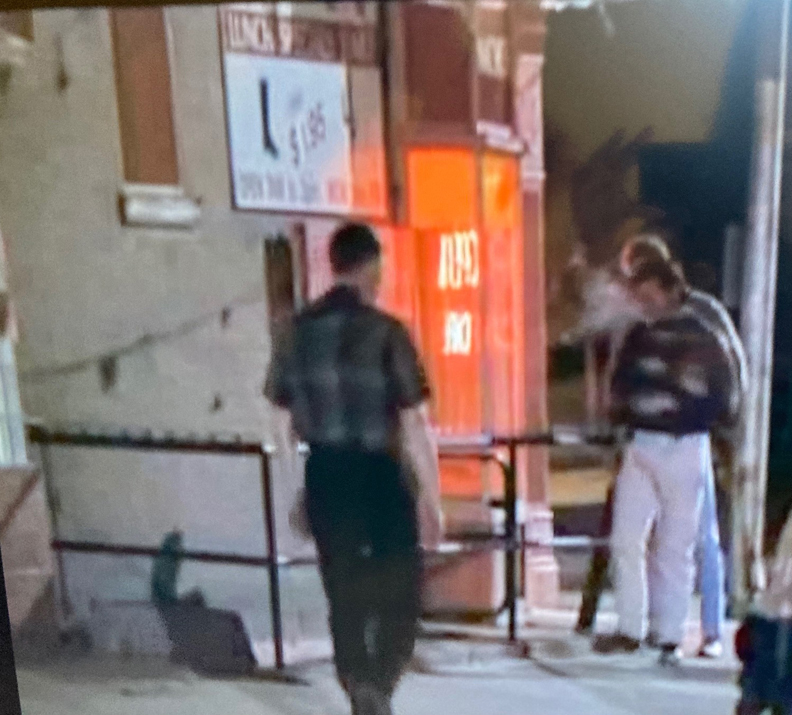
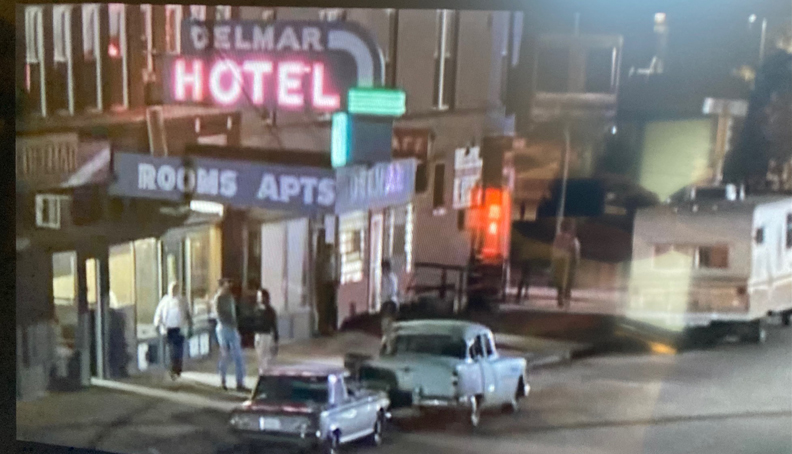
How I remember the Delmar Hotel looked when I was in high school. I always looked when passing east on Douglas Street. I am glad it was featured in The Indian Runner, Sean Penn’s 1991 movie. I loved the forlorn neon lights of this western part of downtown. Penn’s choice of filming location is a testament to the area’s time capsule quality. Images borrowed from The Indian Runner. 1991.
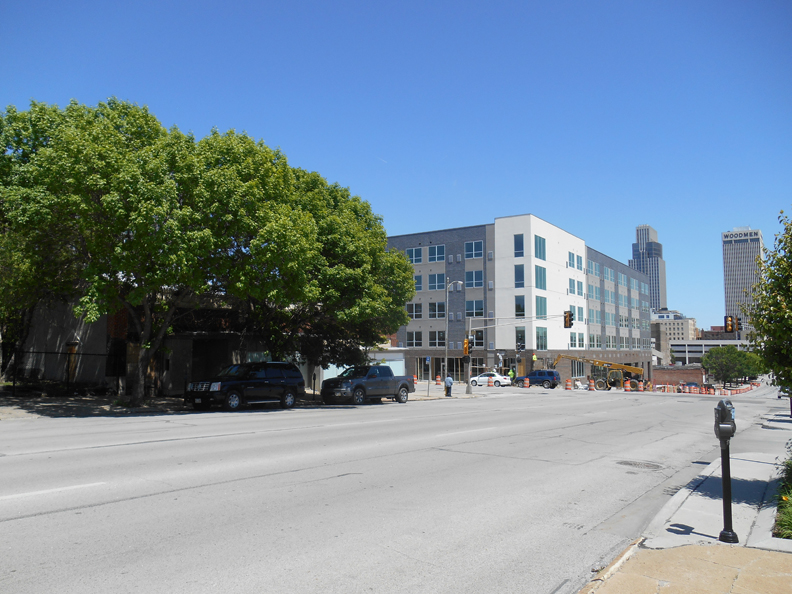
Site of the once Delmar Hotel. Even Hotel in May of 2016, as it is being constructed. Yes, it is of that box-in-a-box style. I am facing east, down Farnam Street. The 24th and Farnam Street building of our focus is on the left, enshrouded by trees. Back when I took this photo, I thought 2406 Farnam was getting ready for a big renovation, just like the newly rehabbed Powers turned Junction Building to its south.
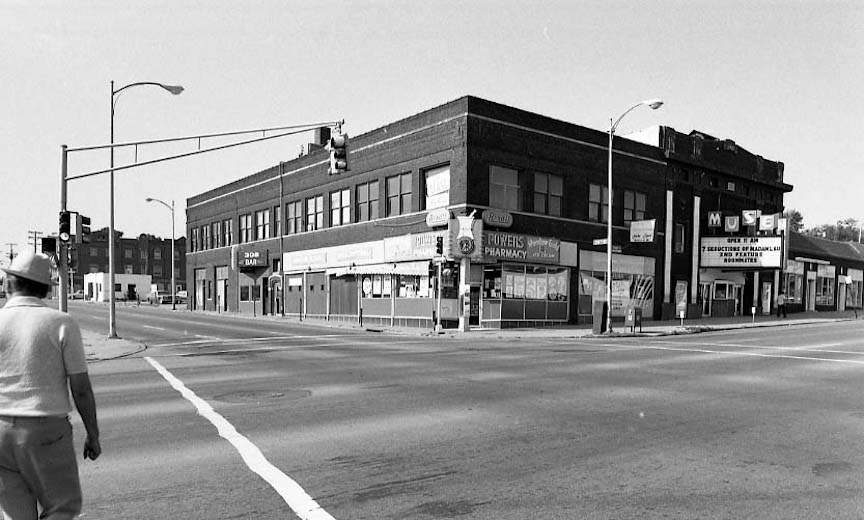
This great photograph from the 1980 Douglas County Reconnaissance Survey wonderfully captures the original 24th and Farnam corner. Seen to the far south is the 308 Bar. On the corner is the Powers Pharmacy. The Muse Theater is seen in the west.
I think the Leonard Powers Pharmacy, in the 1980s called Powers Rexall Pharmacy (southwest corner of 24th and Farnam at 2401 Farnam), might have still been open, although I don’t recall it. Leonard Powers owned a number of local pharmacies, the 24th and Farnam location his most popular. (Mr. Powers passed away in 1992.) I would discover from old photos Powers Pharmacy had originally been on the southeast side of 24th and Farnam at least in the early 1950s. I am not 100% on when the pharmacy switched to the southwestern corner building but it is interesting to note that 2401 Farnam was called the Powers Building. Elmer McCann, pharmacist, had worked in the store and later bought the business in 1978—at some point it became Powers Rexall Pharmacy. Unfortunately the pharmacy was closed in the early 90s, perhaps related or not to a recent Medicaid fraud investigation by the FBI, going on all over town. ‘Twas a pity. Whatever McCann’s reasoning for closing, he was not alone. Many of the stalwarts of the area began shuttering in the 90s. The popular Grove Juicery and Wellness Café is now in the renovated 2401 Farnam location. Such a beautiful space they’ve created. I covered this in the Muse Theater investigation, when it was a photo studio.
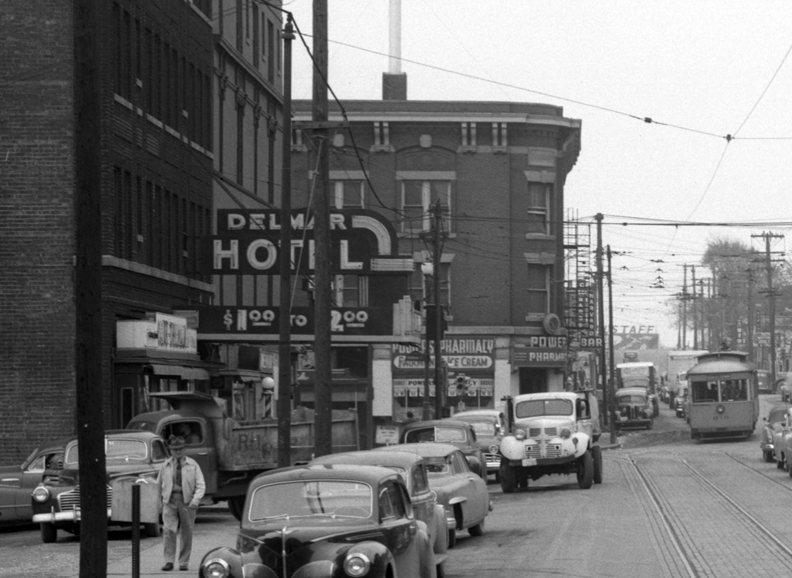
Looking south on 24th Street from Douglas Street. The Delmar Hotel is on the left hand side. Across Farnam Street, on the southeast corner is the original Powers Pharmacy, street level of a hotel building. This structure is now gone—part of the large Federal Reserve parcel. Creator: Bostwick, Louis (1868-1943) and Frohardt, Homer (1885-1972). Publisher: The Durham Museum. Date: May of 1950.
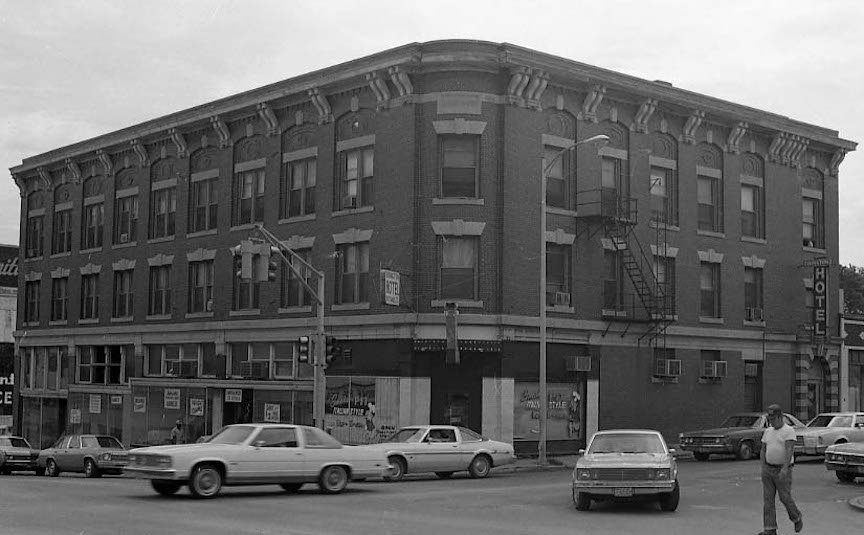
**Addendum of August 2025** The missing structure was called the Edington Hotel at 2239 Farnam Street. Built in 1910, she was a pretty one–designed by Omaha famous architect, George B. Prinz. At the time of this 1980 Douglas County Reconnaissance photo, the original Smoke Pit was on the first floor.
Two standouts for me were the 308 Bar (308 South 24th, eastern side of the Powers Building) and the Downtown Boxing Club (above the Powers Pharmacy). As if the idea of a boxing club wasn’t enough of a classic charge for the senses, seeing this club’s letters in the windows above a pharmacy seemed entirely old school. These were still both going strong not that long ago. I would discover Ben H. Simons was born in Russia and came to Omaha in 1918. He opened the Ben Simons Bar in 1937 at the 308 South 24th Street location and ran his neighborhood pub there for 40 years. He retired in 1977. I think it might have continued on under his name for a while. (Ben Simons passed in 2000.) Barney’s 308 Bar, as I knew it, ran their establishment from 1984 to 2012. Well I guess I didn’t always know it as Barney’s but I did enjoy their “Bikers Welcome” sign. They infamously peddled “The coldest beer on 24th between Harney and Farnam,” a catchphrase with a wink. Love those classics.
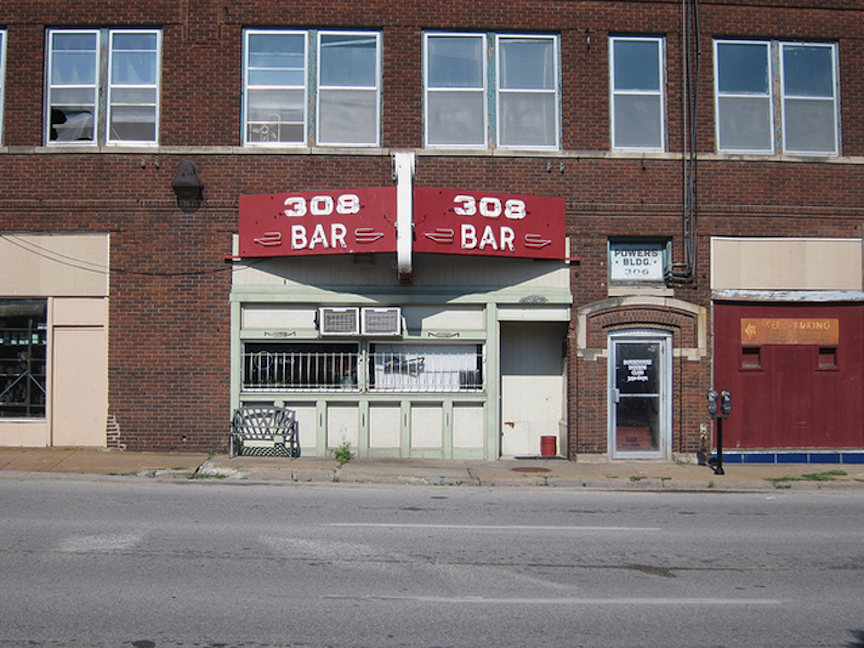
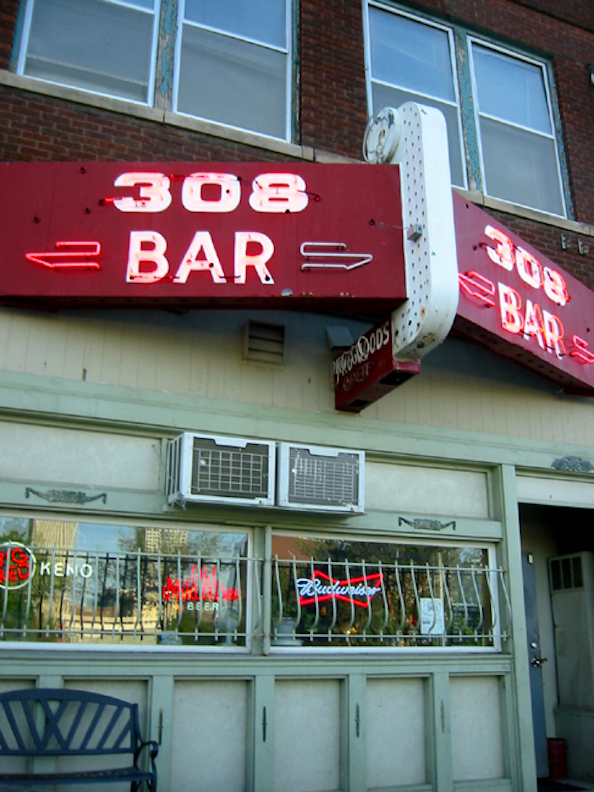
308 Bar in 2011.
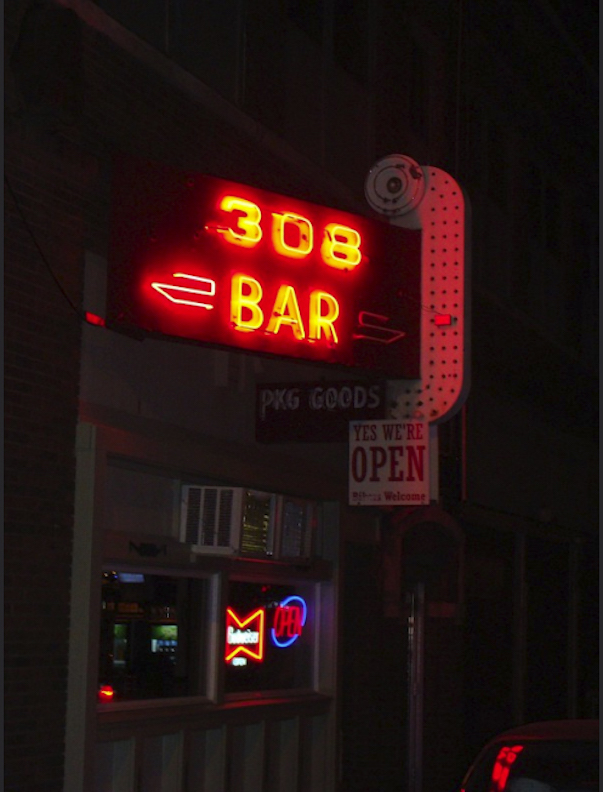
Great 2008 photograph of the 308 Bar neon sign. Photograph by Admiral 58.
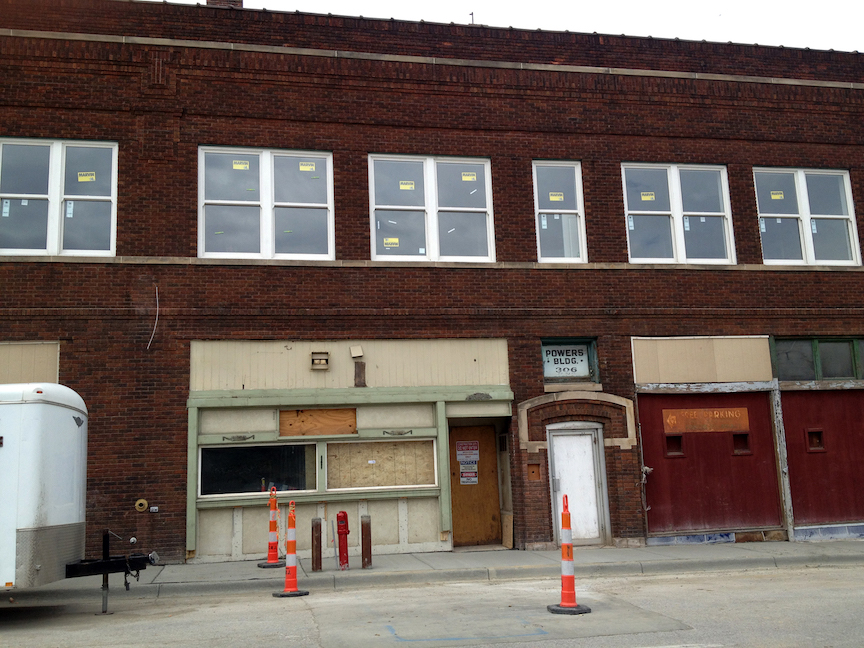
October of 2016. East view of the Powers Pharmacy building. Downtown Boxing Club once housed on the second floor. Site of the 308 Bar in the bay left of the door.

Downtown Boxing Club letters seen in the southern windows above. 2016 renovation.
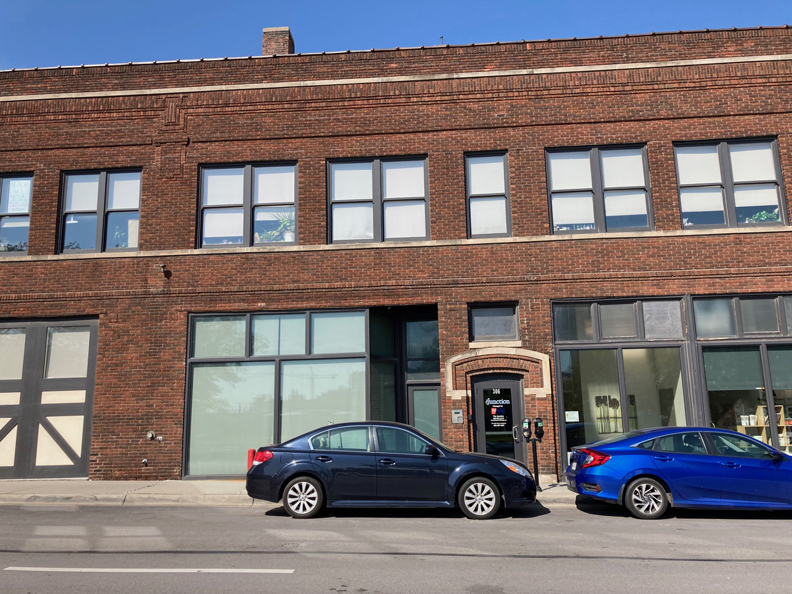
The new-fangled, once 308 Bar entrance. The Powers building as it looks now. Renamed The Junction.
We also observed the remains of the adult Muse Theater, mysteriously closed in 1984, the Smoke Pit barbeque restaurant up the way and its adjoining, Backdoor go-go club at 230 South 25th Street and the Fraternal Order of Eagles Club or FOE Hall at 201 South 24th maintained the northeast end of the block (and is still there!) Imperial 400 Motor Inn turned Econo Lodge at 2211 Douglas was another fascinating spot, that I was both magnetically drawn to but physically avoided because there were rumors of people being killed there and in the back alley. This alley runs alongside the F.O.E. hall, behind the suspect motel, parallel with Douglas and I still can’t go down it to this day. However this perilous proximity did not prevent us for snacking on fries and coffee, some chain-smoking or chomping on ice, in the strange little diner out front, apparently a consensual loitering spot for both punks and sex workers.
From the late 1960s on, the area of 26th Avenue to 25th Avenue in and around Farnam Streets had been Omaha’s retreat for female prostitution, with male workers joining the ranks in the late 1970s. During the eighties, sex workers were increasing in the district; they say the prostitution heyday of the 1980s coincided with the Ak-Sar-Ben horse racing crowds’ peak but I am not sure of that. Back in this time, Larry Kavich, president of All Makes Office Equipment at 25th and Farnam, described the scene on the sidewalk in front of his business as “something plucked out of a Federico Fellini movie.” But even in our high school thrifting days, the daylight street walkers had openly begun plying their trade up and down the 24th thoroughfare, as it was widely known Officer Melvin Berney didn’t start his beat from Dodge to Leavenworth until 6pm. From Howard to Leavenworth on 24th and particularly the favored circuit of Douglas to 24th to Farnam to 26th was highly populated.
Once steered to the right track, these John’s cars frequently pulled to the curbside to solicit the Ladies of the Night (and Day). Everyone knew what was going on and it was out in the open. Equally as courageous, this was a time when prostitutes dressed in fantastic, colorful, shiny and explicit attire, complete with stiletto heels. When I was a child these shimmering ensembles seemed to correspond with the satiny roller-skating and disco trends of the 70s and in my perspective, became more outrageous as the 80s wore on. Frederick’s of Hollywood and Berman’s Leather Store’s offerings at the Westroads seemed to correspond with these fashion changes and come to think of it, I was never in Cosmos Wigs at 1517 Farnam when a beautiful woman of the night wasn’t also there admiring the latest headdress.
The Smoke Pit appeared as a respite, open till 3 am, for all types of late night characters, not just sex workers. I had heard the long-lived Flame Bar, a southern-facing bay within our 2406 Farnam obsession, had served a similar purpose for prostitutes in the 70s—both a resting area and a place to drum up business. As with all important cultural phenomenon in the 70s and 80s, the artists and vice and underground communities coalesced in the same late night bar and restaurant scene. Or maybe that was just Omaha? Not a lot of places to hang out in those days. All the while there were also many older people back then, other regulars and wanderers, down on their luck types, on the sidewalks. I’m not going to say the daytime pavement was full of pedestrians–to the contrary. There was always enough distance to get a real look-see if you needed to quicken step. These folks all seemed to unfold from the nearby inexpensive apartments and rooming houses of the area. Maybe some were just passing through? Meanwhile there were many businesses and their employees making it work and making a living, interspersed throughout what was highlighted in the news as a failing area. Such was the fabric of life in this overlooked crossroads. An outlander through and through, I was hungry to understand what I saw as an exotic, gritty, self-sufficient city within the city. I knew these densely placed buildings, their neon lights and the worldly cast of characters had seen things I could never know. My imaginings led me to the conclusion that these local inhabitants were drawn to this movie set because of its stylish, abandoned quality.
Click on photos for enlargement and further details.
- Camera facing west—the corner of 25th Avenue and Farnam. The great All Makes business in the once Studebaker Showroom. Photo from 2016.
- The Flame Bar in the south western-most bay of our 2406 Farnam building.
- The north-facing Imperial 400 Motel at 2211 Douglas as I remember it looking. The little diner was like a Steak n Egg restaurant or something. I can’t remember the name but I can tell you where the jukebox was! The kind of place I always craned my neck in passing to see who was loitering about. 1960s postcard.
- Smoke Pit in October of 2016. 25th and Farnam. The famous Neal Diamond billboard! The Backdoor was on the northern end.
- Fraternal Order of Eagles Club at 201 South 24th. How it looked in Spring of 2016. I love this place. I have been to see a handful of punk shows at this hall over the years. These were always very nice people working here. Have you ever been dancing at the hall?
Devotion
Boarded up and left in a state of dereliction, I am of the belief 2406 Farnam possessed the architectural attributes worthy of a great renovation just waiting to be—the perfect comeback story. Shabby but spacious, any renovation would have immediately been a widely embraced improvement. I envisioned a large experimental space, tons of windows, with retail bays, put immediately to work. A killer hair salon. A pizza shop. Obviously that never materialized, the building, most likely, only a minor character in most people’s book. Let’s be frank, there is no satisfying people with creative rehabilitation, when they have their hearts fixated on a fresh new box.
For myself, I needed to know more about the particularly characterful one-story building and especially her origin within those extra-close quarters of that city block. This will not be a sob story. This will not be a “this is why we can’t have nice things” tale. Many of you already know my pastime is to track down the long-loved and the quirky. I became obsessed with restoring some semblance of a corner or at least to redeem her in some way, if I could, and prove that she was once a contributor. She did not let me down.

August 27, 2021. How the 24th and Farnam corner stacks up today. Hamilton Garden Apartments on the north side. The low, white buildings seen on the left side are the parking garages of the Hamilton tenants.
Dawn, Early Corner
I began assembling clues. There were a few threads that I would follow to their end. The Hamilton Hotel was erected in 1905 as a three-story apartment house. Four years later three more floors were added and two more came later still. Aside from its steel construction and concrete foundation, the Hamilton Apartments, as it was also called, would become a hotel-apartment building, a combination of permanent residents and temporary guests staying in proper hotel rooms. For clarity I will refer to this as the Hamilton Hotel from now on, although, keep in mind, this was truly an apartment house-hotel. The Hamilton Hotel was once famous for its beautiful contemplative lawn, flowers and palms in summer. There were linens, real silverware and bellboys. Part of my fun in scouring for hints is to find the intriguing notices of what was lost and found in a building’s area. This corner, the hotel and their gardens had seen the days of the lost mink muff, gold mesh bags and all manner of finery, short of a glass slipper. The Hamilton Hotel shared this courtyard for quiet rumination with the addition of the 1907 “second Hamilton Apartment House,” built on the northern perpendicular border of the large lot. However this second Hamilton building was a bachelors’ apartment house, exclusively. It was an unusual joining, architecturally speaking, but handsome in its curious way. But even before the Hamilton buildings had acquired their impressive courtyard offering, apparently there was a large residence that once sat on the northwest corner of 24th and Farnam (where 2406 Farnam would later appear)–the kind of household that needed a large servant staff to govern its daily functions. This corner was once the site of Senator John M. Thurston’s Mansion.
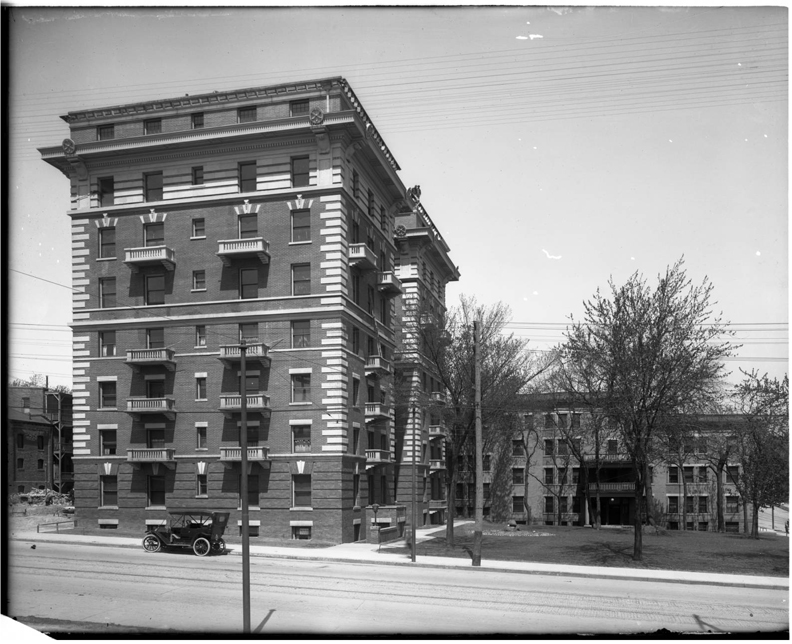
1910. The Hamilton Hotel Apartment–a residential hotel, not unlike the Colonial Hotel on 38th and Farnam. Check out the Brothers Lounge and the Case of the Vanishing Mom and Pop article for more on the Colonial Hotel. The taller of the two buildings was later razed. The smaller of the buildings remains to this very day. This photo faces north across from Farnam Street. (Photo courtesy of the Bostwick-Frohardt/KM3TV Photography Collection at The Durham Museum Photo Archive).
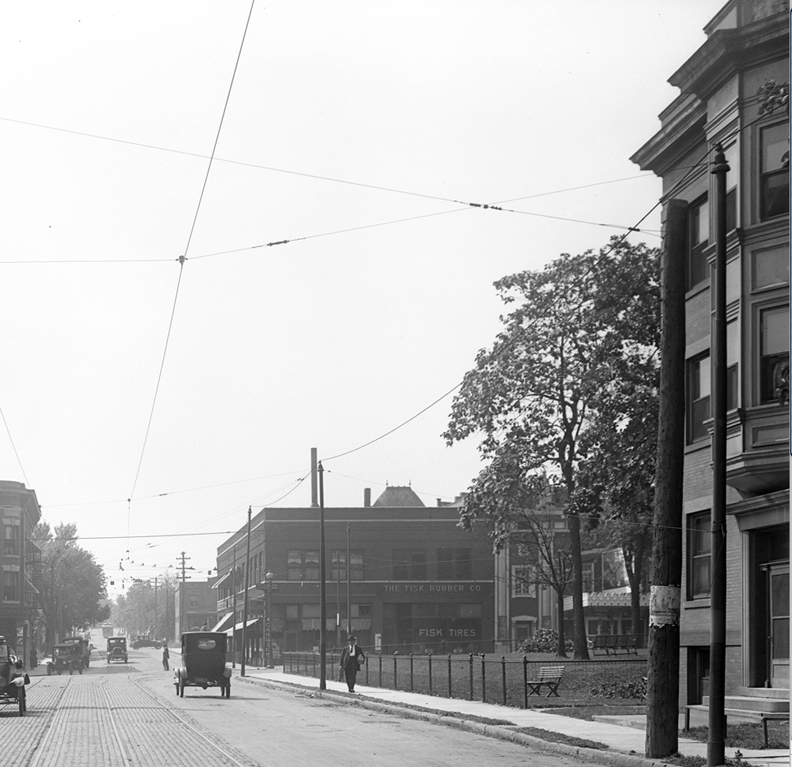
24th Street facing south. On the right is the second Hamilton Apartment House for men and the fenced in large garden space. The Fisk Rubber Company business and the Muse Theater are seen facing north, across Farnam Street. (Photo courtesy of the Bostwick-Frohardt/KM3TV Photography Collection at The Durham Museum Photo Archive).

1912 postcard. Divine!
By 1916 Robert P. and Ed O. Hamilton sold the Old Hamilton and New Hamilton Apartments with the land “160 ft on Farnam and 186 ft on 24th Street” to a small syndicate formed by George & Co. and Ernest Sweet for $375,500. We have discussed George & Company in our past wanderings of Dundee, Fairacres and the Happy Hollow neighborhoods. This was a real estate company operated by brothers Charles C. George and John Edward George. It was interesting the George & Co. fell off the Hamilton books and later Sweet’s contribution would be bolstered to $400,000. I began finding advertisements for the new phrasing of the “Hamilton Apartment Hotel” and “Hamilton Hotel” in 1916.
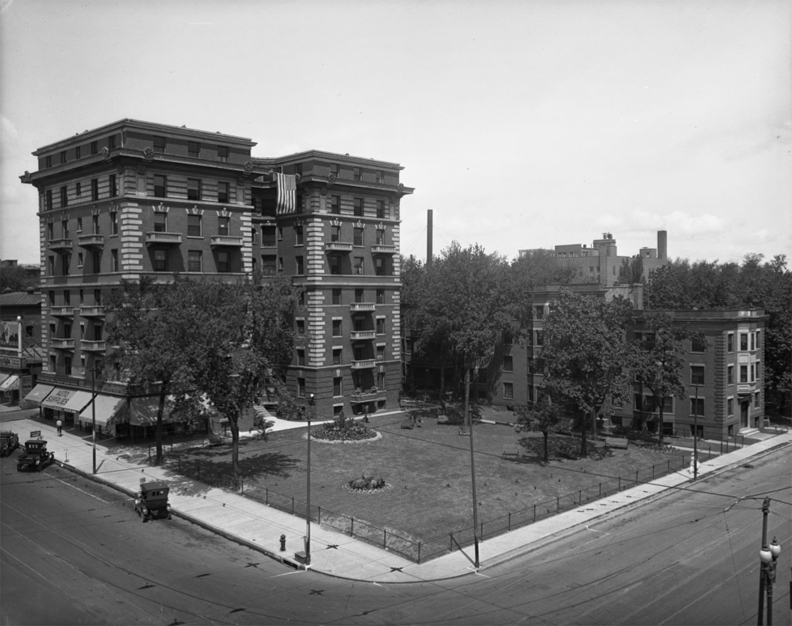
I love this image. Great feel for the becoming complex. Looking northwest from 24th and Farnam Street. Hamilton Hotel at 2412 Farnam Street. The Hamilton Apartments seen on the northside. Creator: Bostwick, Louis (1868-1943) and Frohardt, Homer (1885-1972). Publisher: The Durham Museum. Date: July of 1918.

1921 postcard, gives clarification.
Ernest E. Sweet
Mr. Ernest Sweet was a big-time real estate developer in Omaha–his business office was at the prestigious New York Life Building downtown. Sweet was known for having acquired and developed many high-end properties around town. He made the news in the early 1900s for equipping all of his flats and suites with personal safes, a real decadence and perhaps a sign of the crime-filled times in the big city. (Have I already told you a million times how much I loved having a personal safe in the bedroom closet of my Ambassador apartment? No matter that I did not have the combination–the luxury of that opened black safe made me dream of the pretty ladies of the past! A good place to put a Mary statue. ) Sweet’s name was frequently mentioned with the rise of apartment buildings in the 1920s. As owner of the Hamilton Hotel and Hamilton Apartments, he had acquired a fine moneymaking quarter on the edge of downtown but truly, the further I dug, I found he owned flats all up and down 24th Street.
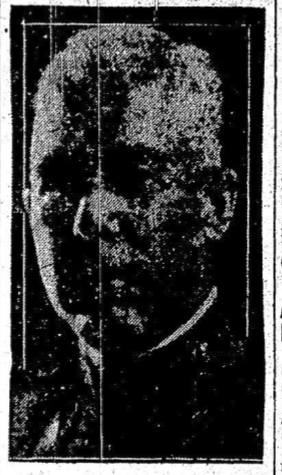
Ernest Sweet. Photo borrowed from the OWH archive.
Introducing 2406 Farnam
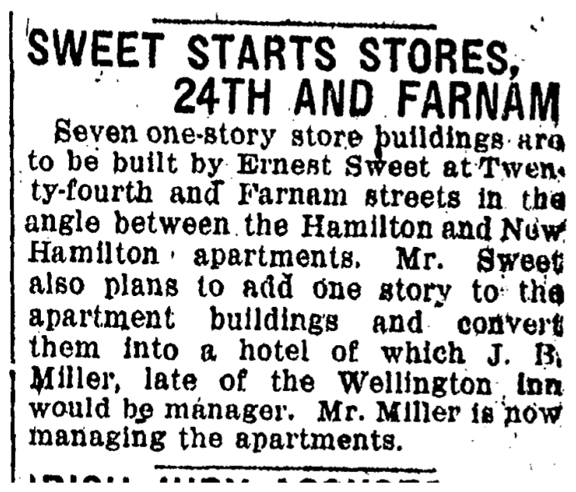
April 17, 1920 OWH archive. My first significant clue. Mr. Sweet builds “in the angle” between his other two buildings.
Shortly thereafter Mr. Sweet “closed a contract with Home Builders, Inc.” for erection of his new store building. Most interestingly, the number one clue in my estimation, was to read of who designed my well-aged beauty: “It was designed and the work will be supervised by John Latenser & Sons. The cost of the building will be about $60,000. The entire storefront construction will be of the latest type, consisting of copper work and plate glass. The building will be faced with mat textured brick and terra cotta, which affords an improvement over the prevailing architectural features of Farnam Street. At the rear the walls will be designed in plastic stucco and stone work with trellises, seats and colonnades of a style in keeping with the appearance of the adjoining apartments. Inside the building will be trimmed in marble and terrazzo. Steam heat is to be furnished. Prospective tenants include drug, show, women’s wear, haberdashery, jewelry, electric, and many other merchants.” April 1920, OWH archive.
I was particularly intrigued to find that Sweet’s one-story building, later assigned the address of 2406 Farnam, was designed by John Latenser & Sons, because of their prominence. This made so much sense, for although Sweet’s building of shops was not fancy by any means, it did have that panache that called to me. This clue also signified that Mr. Sweet meant business and wanted to upbuild the district. It does stop me in my sleuthing tracks to consider that in some towns, the Sweet Shops might have become the happening spot, a center of life.
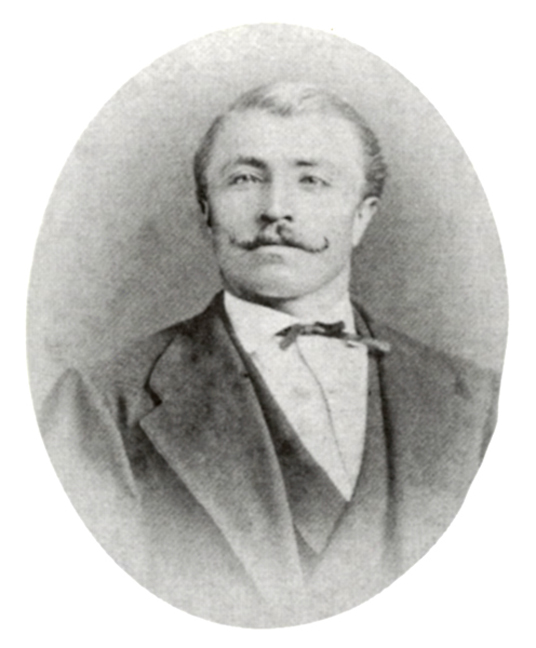
Architect John Latenser, Sr. began life as Johann Laternser. (1858-1936)
Latenser & Sons were a reputed architectural firm, having designed many of the important institutions downtown. Omaha Central High School, Douglas County Courthouse, Brandeis & Sons Store, Temple Israel (now St. Johns Greek Orthodox Church), and Scottish Rite Temple, to name a few. “In 1915 Latenser brought his two architect sons, John, Jr. and Frank J.–both of whom had already been working for him–into the practice. The new firm became John Latenser & Sons, a name that remained prominent until 1978, through the practices of the second and third generation of Latenser architects in America.” For more info on this great family firm, check out:
http://www.e-nebraskahistory.org/index.php?title=John_L._Latenser_%281858-1936%29,_Architect

May of 1920, OWH archive. The building permit filed in Mrs. Sweet’s name. More on the Mrs. in a bit.

By October 4, 1920 the papers promised Sweet’s seven stores would be finished by mid October. “Leases on four stores are now ready to be signed.” In December of 1920, they were advertising for tenants. Image borrowed from OWH archive.

Current image of 2406 Farnam footprint borrowed from the Douglas County Assessor’s site. For people who can interpret such measurements and things, here is the vague-ish lay of the land of Sweet’s 1920 building. Note the second floor and partial basement. Do the indented spaces correspond with the initial seven stores?
**Addendum of September 21, 2021. The fabulous Kristine Gerber just sent along this link of the original architectural plans from the City of Omaha. I included some details from this pdf below. Thank you, Kristine!
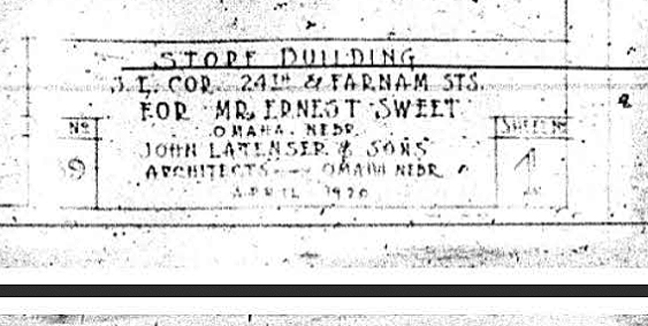
The Architect’s Title Block, bottom right hand corner. The first page of the plans let on building was originally given the address of 2402 Farnam Street. Also the plan was approved by the city on May 11, 1920.
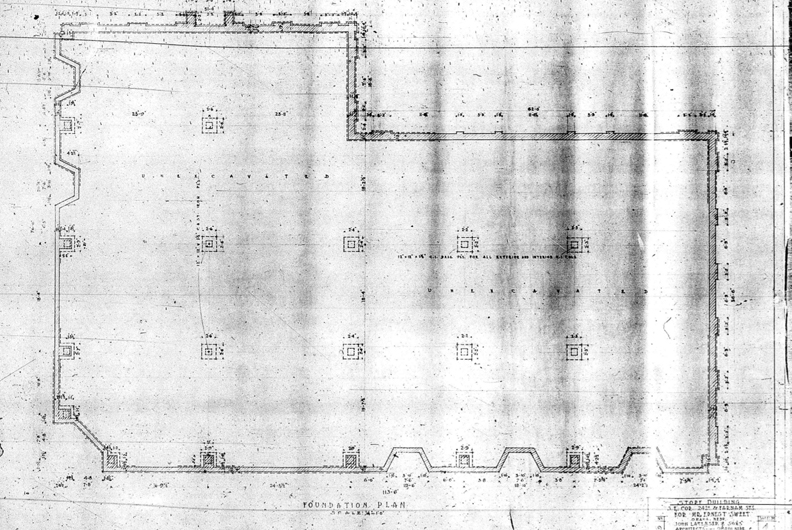
Original foundation plan. Interesting to compare it with the above, contemporary plan.
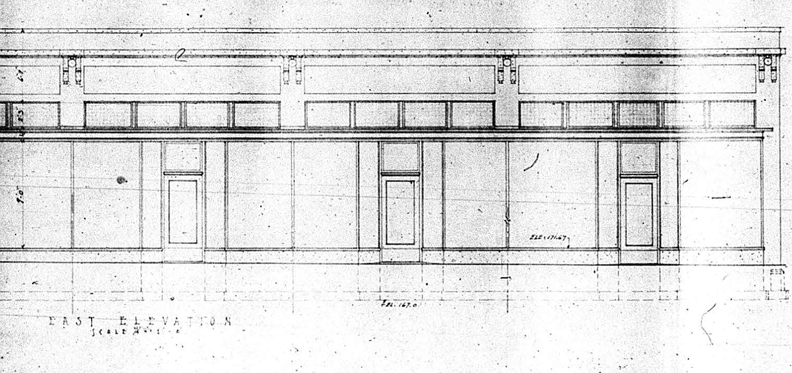
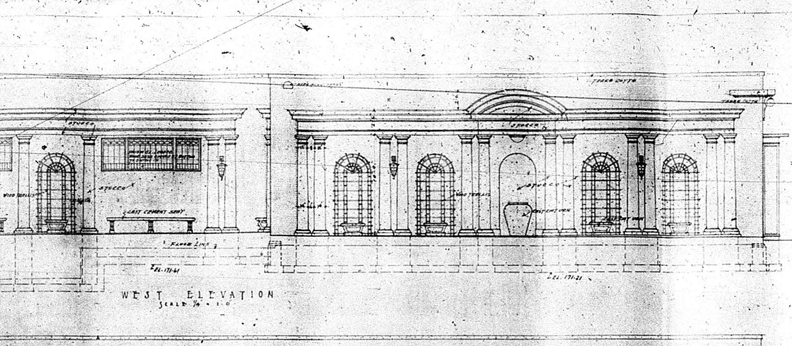
Eastern elevation above. The western elevation below, displays fancier, courtyard-like details on the side that faced the Hamilton Hotel. Wish I could have seen it in its day!
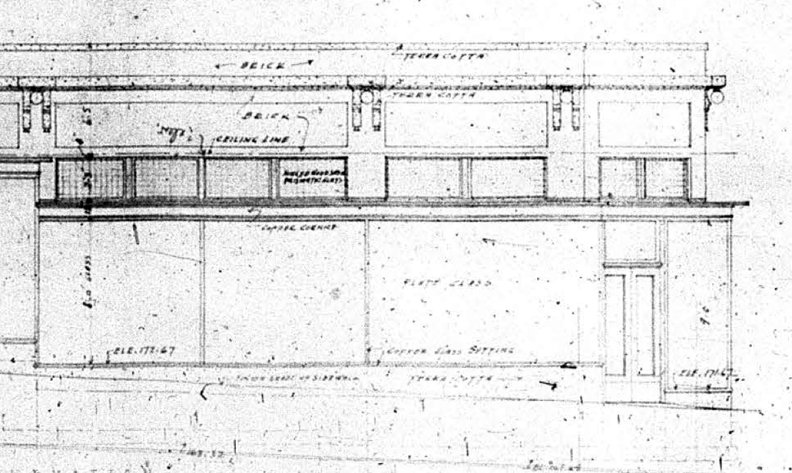
Southern Elevation shows specifics of that glazed terra cotta “lip” I so loved. Brick work, ceiling line, copper edging, plate glass windows and those cute globe lights.
1920s Photo Album
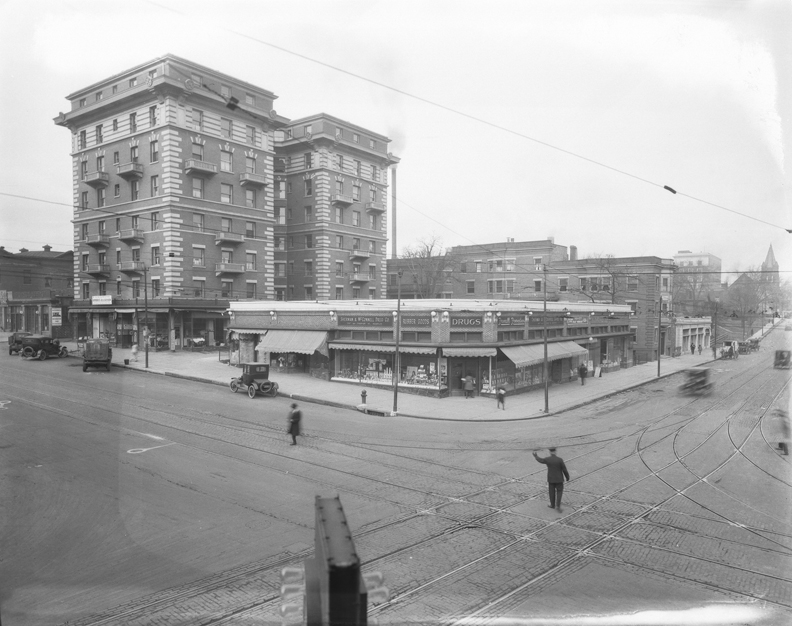
The new Sweet Building on the northwest corner of 24th and Farnam. The Hamilton Hotel at 2402 Farnam Street to the west and the Hamilton Apartments on the northern angle. Looking northwest from 24th and Farnam Street. The large corner bay was leased by the Sherman & McConnell Drug Company. I love the ghost people in the streets. Please magnify for greater pleasure. Creator: Bostwick, Louis (1868-1943) and Frohardt, Homer (1885-1972). Publisher: The Durham Museum. Date: 1921.
Of course I am in love, so I am blind, but it’s interesting to consider what the hotel guests thought looking out onto the Sweet Building rooftop, whereas their eyes previously had a garden to luxuriate in. I do like that passageway between the Hamilton Hotel and the Sweet Building. Reminds me of downtown San Francisco with its hideaways. The Sweet one-story building also significantly changed the experience of living in the Hamilton (men’s) Apartments. Note that the new building does not yet have its mini second floor with gable.
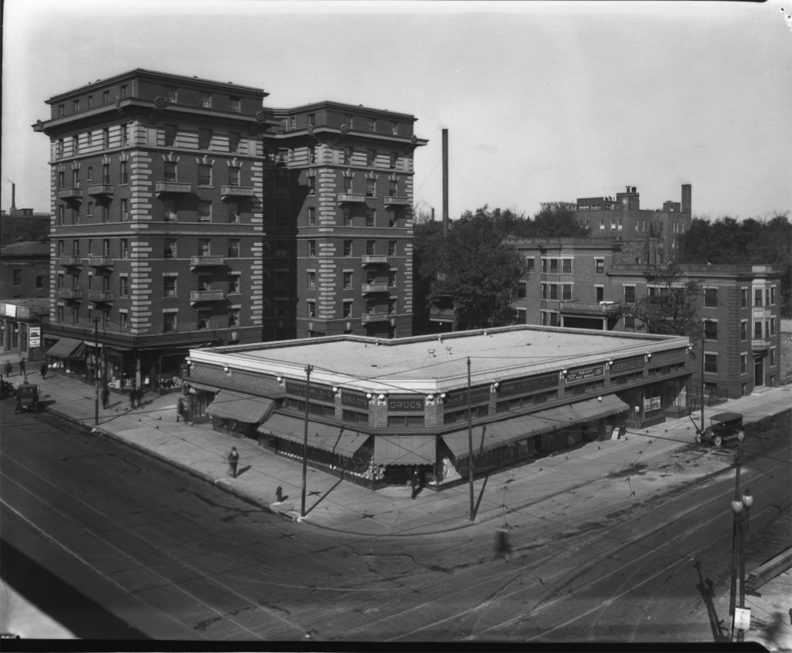
More of that roofline. Great striped awnings. It looks like the bay where the OEA Thrift was located is not yet leased; it has a large sign in the window. Creator: Bostwick, Louis (1868-1943) and Frohardt, Homer (1885-1972). Publisher: The Durham Museum. Date: November of 1921.

Now Liggetts Drugstore has taken over the corner bay. Hamilton Café and Lunch Room are also tenants. Note the building atop the building. The curious front gabled “room” on the second floor. Also it looks as though there is either a formal entrance between the Hamilton Hotel and the Sweet Building or they made an addition. FACINATING. Creator: Bostwick, Louis (1868-1943) and Frohardt, Homer (1885-1972). Publisher: The Durham Museum. Date: 1923.
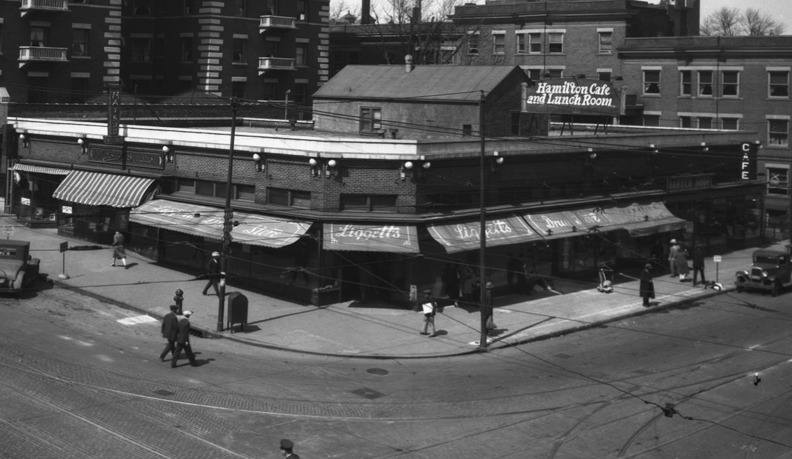
A detail of the above photo. Was this room on top of Sweet’s building one of the downtown card rooms I had heard about? What happened in here and why was it added? Was it used to make hooch and then they shuttled it under the street? Why would Sweet have a connection to the Delmar Hotel when he owned the Hamilton Hotel? The mind spun.
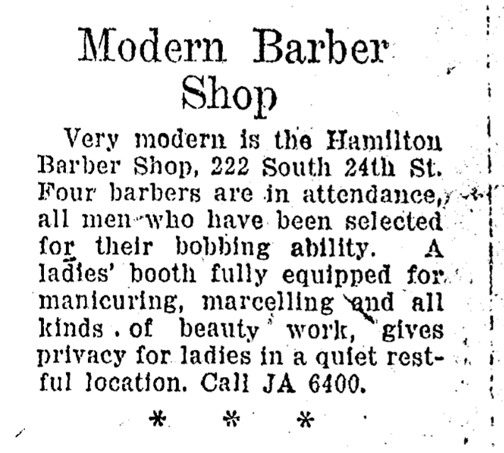
September 6, 1925 advertisement borrowed from OWH archive. Hamilton Barber Shop.
By 1928 the one-story of shops was fully operational and had taken reign of the once Hamilton Hotel courtyard. Liggett Company Drugs is at 2400 on the northwest corner of 24th and Farnam. Rogers Confectionery at 2401 then became the Goody Shop Confectioners. The Spic & Span Grocery Store went in across the street at 2403 Farnam, previously the Fisk Rubber Company. D. N. Hatt Meats was also housed within. 2402 was the Harry Matsuo Photography Studio. 2406 was Cleo’s Beauty Shop. The Muse Theater is now considered 2407 Farnam. The Hamilton Hotel address also shifts to 2410 from 2412-2414 Farnam.
The Mysterious Sweet File
Before we go one step further, we must discuss what happened to Mr. and Mrs. Sweet. Ernest Earl Sweet married Laura Mae (sometimes May) Potter in 1896. I was interested to find that Mrs. Mae Potter Sweet went by Mrs. Mae Potter Sweet, which was unusual for the day. The further I dug it looked as though the Potter family owned a good deal of real estate in town as well. It could be that Mae or the press thought a lot of her family name. By 1922 Mrs. Mae Potter Sweet filed for divorce from Ernest Sweet, charging “cruelty.” In legal terms, cruelty, in those days included both mental (verbal and psychological) and physical abuse. I do not know the specifics of their domestic history. Immediately after filing Mae Potter moved to the Blackstone Hotel. By that summer she was awarded the divorce, custody of their 4-year old adopted daughter, Elizabeth Ann and $300 a month alimony the rest of her life or a $48,500 lump sum. $300 a month is equivalent in purchasing power to about $4,875.05 today.
Perhaps because of this alimony payment, in 1923 Ernest Sweet sold a portion of his 24th and Farnam property to Fred M.Crane for $355,000.00—other accounts says $250,000. (As a side note there are many different accounts on most matters relating to Ernest Sweet.) Another storyline stated Sweet remodeled the Hamilton Hotel and sold it to the Fred M. Crane Company early in 1924 but “kept the lease of the hotel and managed it.” He also reputedly sold the Hamilton Apartment annex to the Crane Company.
In his years of owning the Hamilton Hotel, Mr. Sweet would come to know Miss Martha F. Frankfort (also spelled Frankfurt) his bookkeeper at the hotel. The couple “married quietly” in October of 1923, after the young miss returned from an eight-month stay in California. It is said that the marriage was the “culmination of a romance, which began when the young woman started to work at the hotel.” The newest Mrs. Sweet, then named, “former bookkeeper,” and Mr. Sweet would make their home at the Hamilton Hotel. Which is my dream—to live in a hotel, not to be married to Mr. Sweet.
Oddly in November of 1925, it was announced that Sweet was disposing of all his Omaha holding and leaving for Los Angeles. I only say oddly because there were many stops and starts in this process. He would apparently sell his lease and the furnishings of Hotel Hamilton to a Mr. D. A. Maccuaig. Something tells me the new Mrs. Sweet was not impressed with Omaha.
It was again proclaimed that the Sweets were moving to California in 1926– and in 1926, the remaining portion of Sweet’s 24th and Farnam parcel was purchased by Dr. Harold Gifford for $205,000.00. Before leaving Omaha for the west coast Ernest Sweet was rumored to have “lost heavily on many of his investments,” although a review of the sales shows that Sweet made quite a profit. Perhaps he had originally bragged to the papers about these sales? Or maybe he had to unload his parcels quickly and didn’t get what he need on them? Lord knows I am no real estate developer and don’t know about these big money matters. I do know that to this day there are Sweets Subdivision, Ernest Sweets Addition and 2nd Addition in Omaha, all platted by our mysterious Mr. Ernest Sweet. Additionally Mr. Sweet, in association with four other Omahans in the Keystone Investment Company, held control of the Peters Trust Building under a 99-year lease. His holdings in other properties were extensive at that time. He also created the Pappio Golf Club on West Dodge Road. I only share these facts because it wasn’t just the Hamilton Hotel-Hamilton-Apartments-Sweet Building conglomerate at 24th and Farnam that he had to worry about before skedaddling away from Omaha.
The Sweets would settle comfortably into their Beverly Hills home; in Los Angeles Mr. Sweet engaged actively in the real estate business. But by April 30, 1932, our Mr. Ernest Sweet had been accused of fraud. He was reputedly charged with five felony counts in connection with “the alleged swindling of a 74 year old man of property and cash, said to aggregate 50 thousand dollars.” The complaints were filed by the Los Angeles district attorney’s office and charged three counts of violation of the corporate securities act and two counts of grand theft. Bail of six thousand dollars was set pending trial, the date of which has not yet been fixed.” This action made it sound as if Mr. Sweet had alleged manipulation of property entrusted to him.
Shockingly, months later on July 9, 1932, Ernest Sweet died in Los Angeles. “Mrs. Addie Gidley, Ernest’s sister reported the news, however no details or circumstances given.” And no details were ever given. He was described as a leading Omaha real estate dealer and holder of extensive property. “Mr. Sweet’s rise in Omaha business circles was meteoric, Omaha friends recall. Beginning as an employee of the street railway company, he later entered the real estate field where he advanced rapidly.”
I would find the Sweet estate would continue to have a leasehold on Omaha buildings past his death.
The 1930-40s File

The Hamilton Café would continue strong. Here is there advertisement for New Year’s dinner of 1934-35. I cannot resist sharing this. In 1939 Weiner Alterations leased the 222 South 24th bay where one could get a ladies’ or men’s suits altered to the tune of $1.50.

Looking northwest from 24th and Farnam Street. Liggett’s Drugstore is going strong on the corner. The Hamilton Hotel has an incredible new sign Hotel Hamilton. The streetcar skylines are everywhere. Creator: Bostwick, Louis (1868-1943) and Frohardt, Homer (1885-1972). Publisher: The Durham Museum. Date: March of 1942.
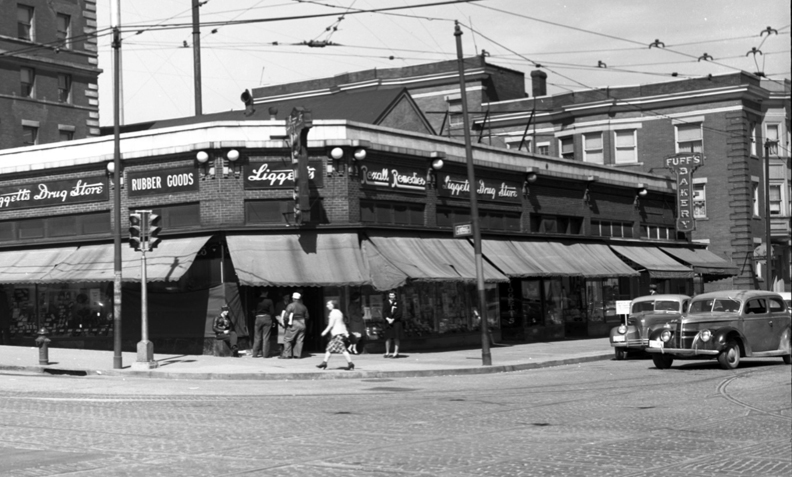
Because I’m weird, this is a close-up of the previous photo. I had to see if that was the 1940s me walking in a plaid skirt. No, really, I had to see if that was the bakery. In this time period Fuff’s Bakery would move into a northern bay, what I think later became the OEA Thrift.
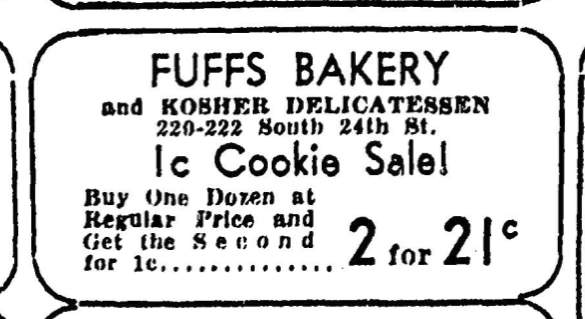
Fuffs Bakery and Kosher Delicatessen? OMG. Yes, please. March 17, 1942. OWH archive.
Andrew Kollias, South Omaha restaurant man, bought the 24th and Farnam property in April of 1944 for $60,000. The Liggett Drugstore, the Matsuo Studio and Fuffs Bakery and Delicatessen were the main anchors occupying the building. The World-Herald erroneously reported that the Sweet Building “was erected by the Hamilton Brothers, who built the hotel and annex some years earlier.” Ernest Sweet was essentially written out of the storyline.
Sidenote: I delight to report the Sweet Building at 2406 Farnam would amazingly stay in the Kollias family name until heirs sold in June of 2001 for $90,000.
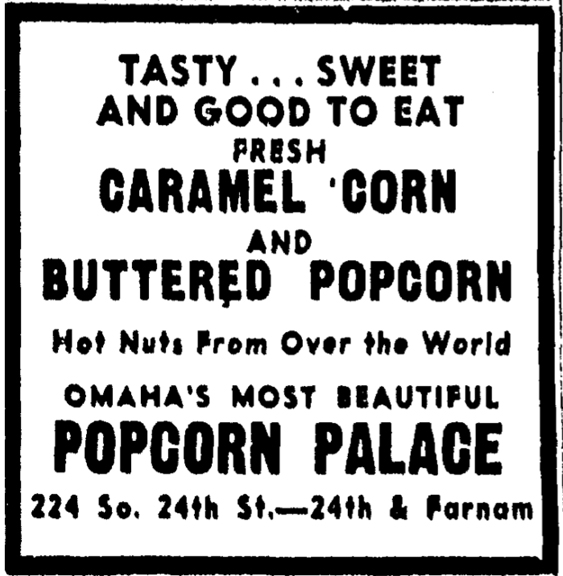
I can only imagine what Omaha’s Most Beautiful Popcorn Palace entailed. November 1946, OWH archive.
The Hep 1950s

Hamilton Hotel at 2402 Farnam Street and the Hamilton Apartments. Ernest Sweet’s building now houses the Thrifty Drugstore and some fantastic signage. Oh yes, and the Flame Bar has entered the picture. Flame Bar from the early 1950s to the late 70s. Looking northwest from 24th and Farnam Street. Creator: Bostwick, Louis (1868-1943) and Frohardt, Homer (1885-1972). Publisher: The Durham Museum. Date: 1950-05-04.
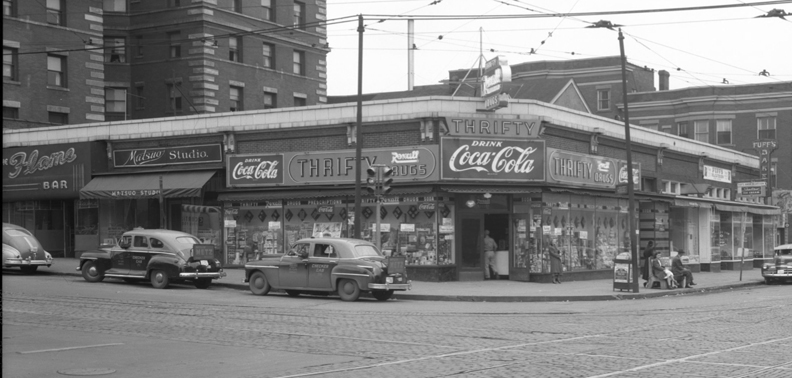
Yum. Another enlargement because I had to. Looks like any number of movie sets that I would love to get lost in.
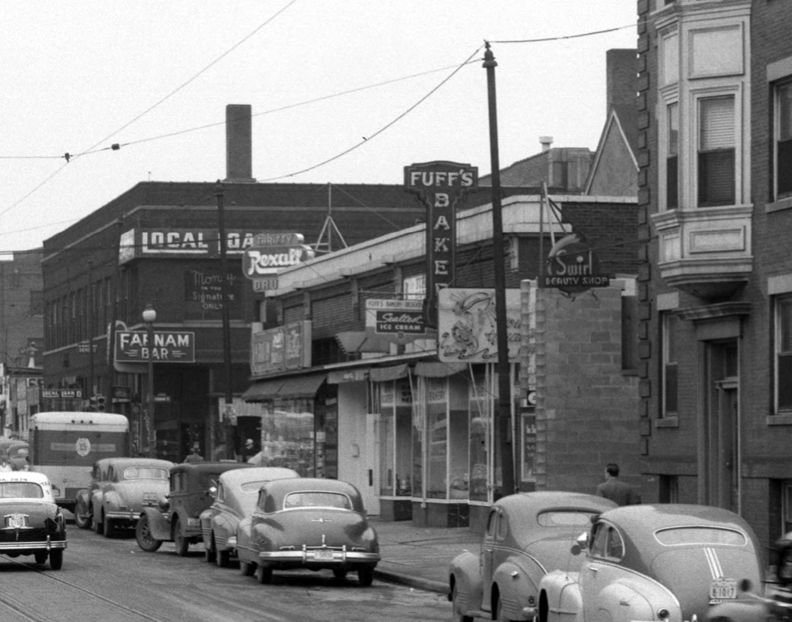
My Fuffs Bakery bay, (I think what would become the OEA Thrift) just south of the Hamilton Apartment building for men—although probably no longer just for men. Farnam Bar, across Farnam Street, would later become the Powers Pharmacy. Interesting to see this bar. Great signs everywhere—not to mention the cars. Camera facing south on 24th from Douglas. Creator: Bostwick, Louis (1868-1943) and Frohardt, Homer (1885-1972). Publisher: The Durham Museum. Date: 1950.

This one has got it all! Looking west on Farnam Street from 24th Street at the streetcar tracks. On the right is the now insanely strange and cool looking Hamilton Hotel. A city bus (O & C. B. Streetcar Railway Co.) is pulling in front of our 24th and Farnam Street building. Creator: Bostwick, Louis (1868-1943) and Frohardt, Homer (1885-1972). Publisher: The Durham Museum. Date: 1953-04-26.
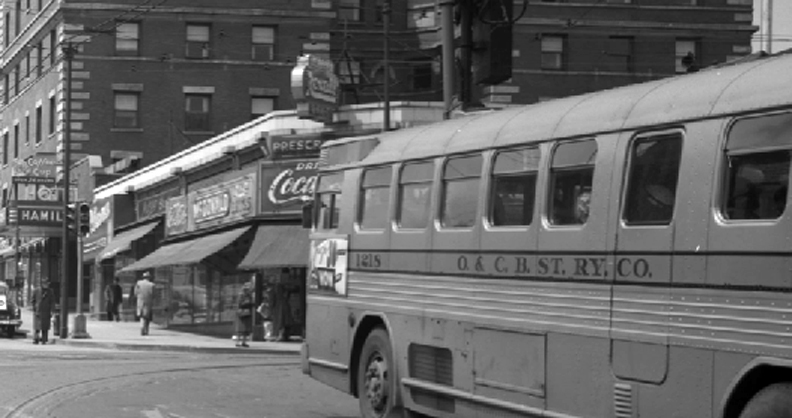
A detail. The Max I Walker Cleaners was a “call in,” fast pick up dry cleaning business with “six plants” in Omaha. Its one customer store was located in the Sweet Building at 224 South 24th Street in those years.

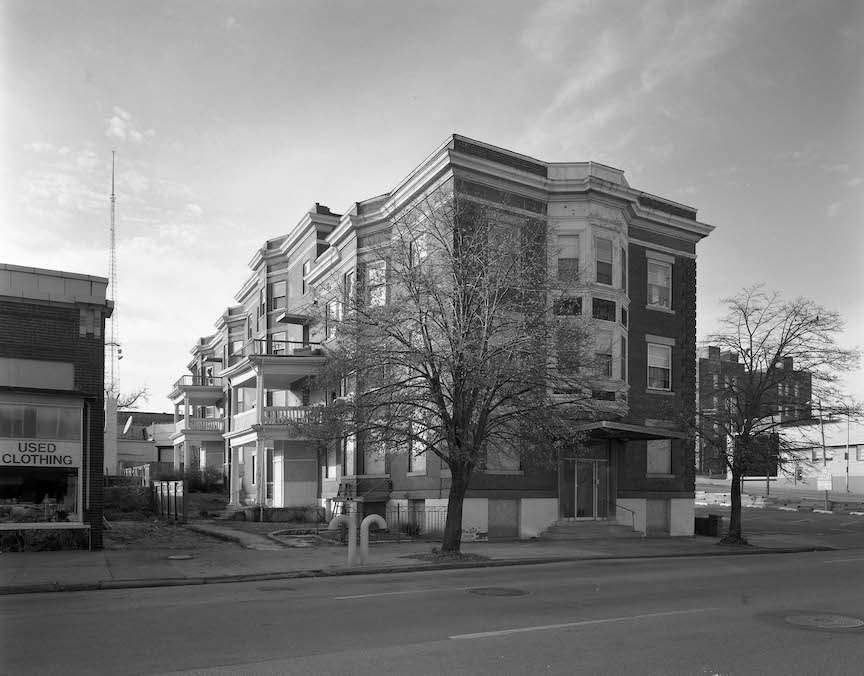
These two great photographs, from the historic Reconnaissance Survey series show how the Hamilton Garden Apartments abutted the Sweet building. The lower image is from 1980. The above photo reveals another structure with a narrow doorway and signage that had been removed. I am not sure if this photo was from the 1970s or earlier in 1980.
The Rest of the Story
The Hamilton Hotel was damaged in a 1977 fire. At that juncture it was long-labeled a “neighborhood problem,” although a well-known judge lived in the hotel, walking down to the courthouse every morning. The city ordered the hotel’s demolition. The Hamilton was razed in June of 1977. At the risk of exposing an upcoming investigation, because there really is so much more to say, the hotel’s owners filed a 1981 lawsuit again the City of Omaha officials and the Fire Marshal. There was an arson suspected fire in the Muse Theater in 1988 and another serious fire in 1998. By 1999 the Muse was torn down. Meanwhile at the end of 1995, prostitution arrests in the area were at their highest level since 1988 (with 537 prostitution arrests.) An arsonist started a Delmar Hotel fire in a mattress in 1996—the hotel was condemned in 1998, later razed in 2001. My little OEA Thrift closed its doors in June of 1998, no longer able to recruit volunteers to come to the 24th and Farnam location.
The Siedliks and their Design-A-Sign business kept the corner of 24th and Farnam Streets going strong for a long time with their cheery showroom. They bought the Sweet building in 2001 but had been leasing in the location since about 1984. They sold to the Anant Enterprises in 2015.
I would like to give a round of applause to All Makes Office Equipment and F. O. E. Hall, the good ol’ Fraternal Order of Eagles 38, for being strong stewards in the area. Long may you live! With respect, if I have overlooked a long haul business within these blocks, I do apologize.
I said I wouldn’t get emotional, so here goes. The End. Back, way back before the Godforsaken internet, I came to love this area by walking around and taking it in. And if anything makes me nostalgic, it’s that. There was a world of mystery where we could only figure it by getting out there. It was charming and dark, at times. Short of finding a glass slipper, the one-story building at 24th and Farnam was something special to me at a time when simple architectural touches were like a signal. A sign from the past. It meant quite a bit. She will be a hard act to follow.
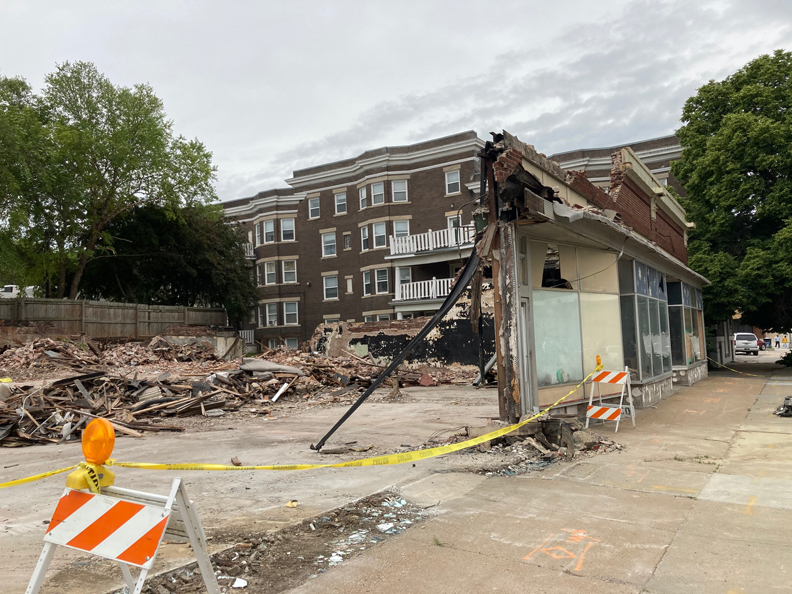
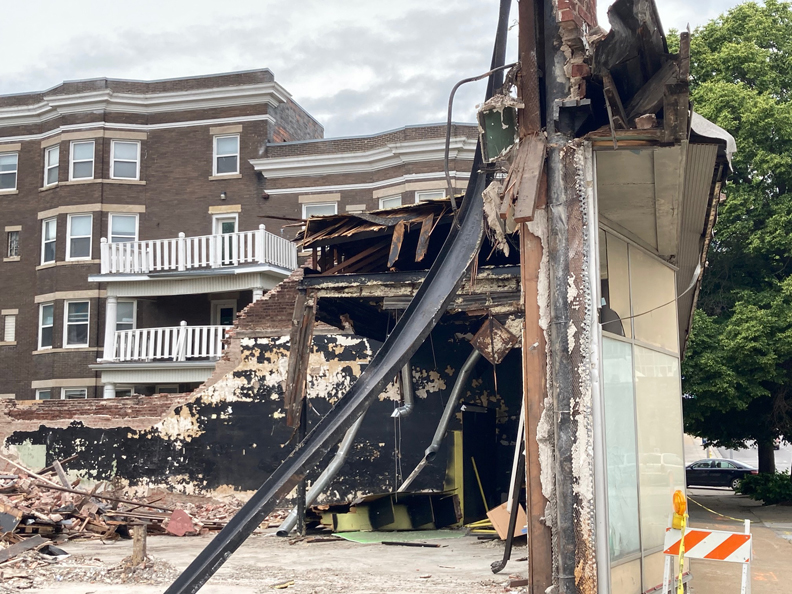
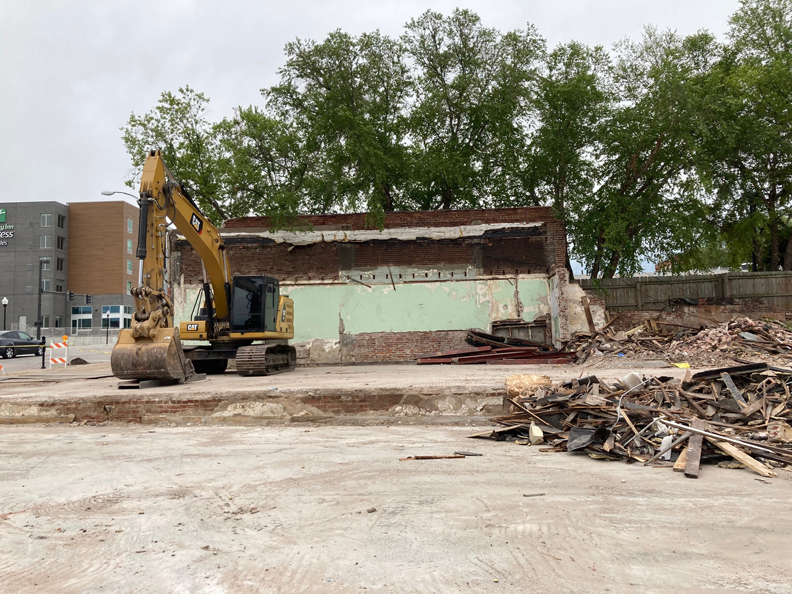
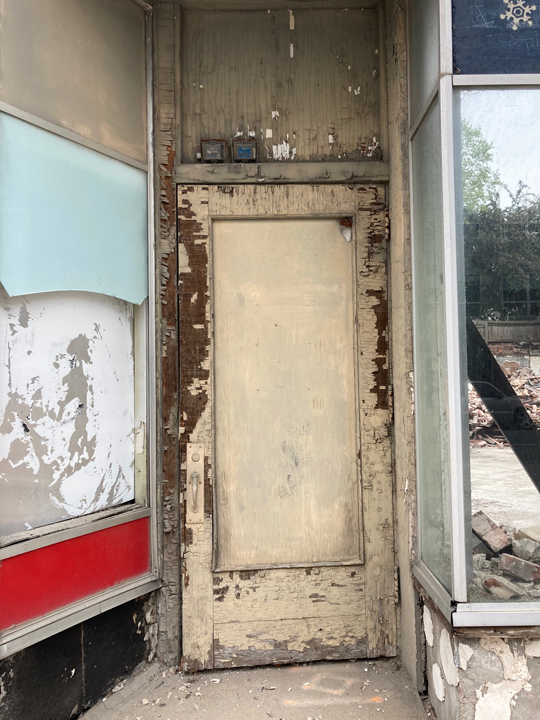

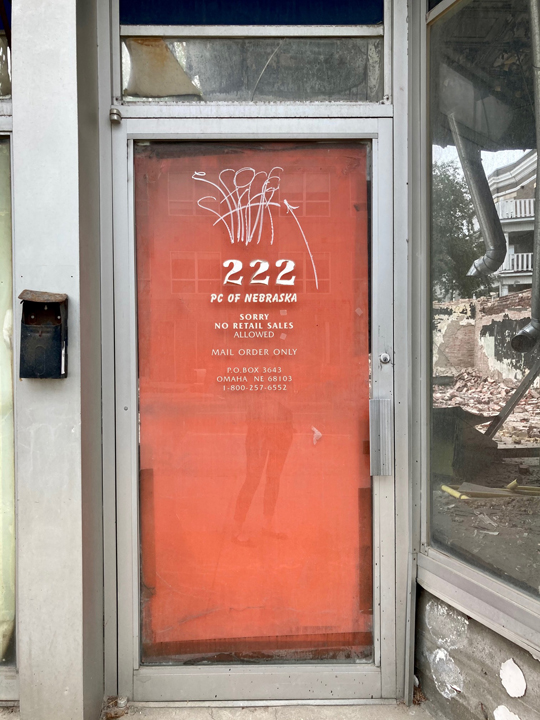
All demo images taken May 30, 2021.

Photos of empty lot and Hamilton Garden Apartments taken on August 27, 2021. I do hope the Hamilton Apartment Building for Men (had to say it) can keep going.
I welcome your feedback and contributions to this 24th and Farnam investigation. Feel free to share thoughts and clues in “Comments.” I welcome you to poke around with your flashlight. Investigate. Hide in the shrubbery. Look under these rocks and down those alleyways. I am more than pleased to have you tiptoe about. By the time you head for home, I hope you have been fully Sherlocked and Satiated. Thank you, detective friends.
If you like what you see, you can keep up with my latest investigations by joining my email group. Click on “Contact” then look for “Sign me up for the Newsletter!” Enter your email address. It will then display “Thank you, your sign-up request was successful!” Make sure to check your email address to confirm. You will get sent email updates every time I have written a new article. Also feel free to join My Omaha Obsession on Facebook.
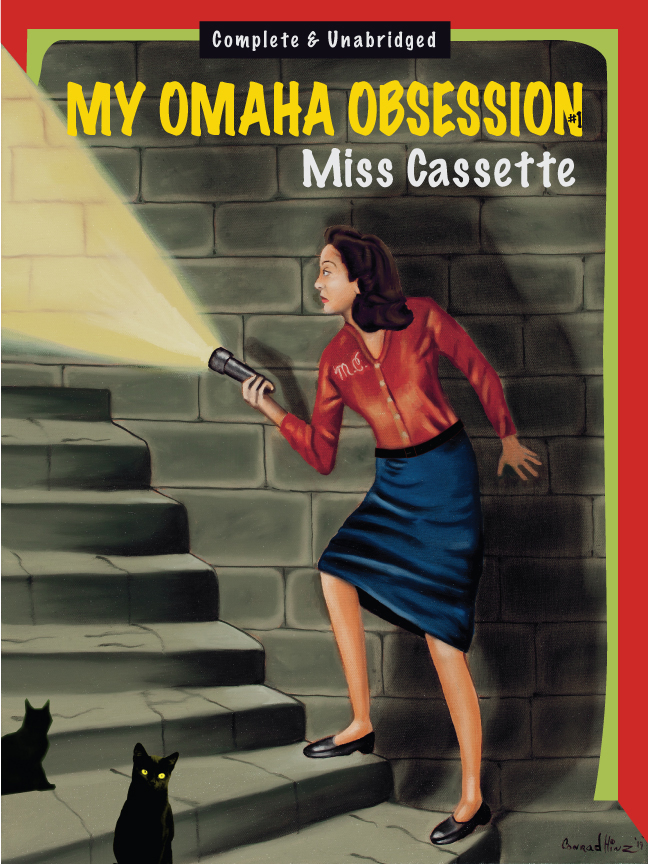
© Miss Cassette and myomahaobsession, 2021. Unauthorized use and/or duplication of this material without express and written permission from this site’s author and/or owner is strictly prohibited. Excerpts and links may be used, provided that full and clear credit is given to Miss Cassette and myomahaobsession with appropriate and specific direction to the original content.
If you are looking for more architectural and Omaha history sleuthing fun, ask your local or big box bookseller for my new book: My Omaha Obsession: Searching for the City. You can also order it through this website. Thank you.

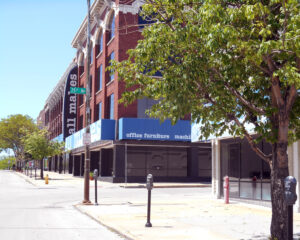

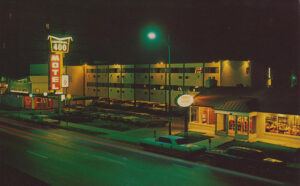
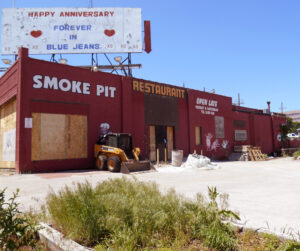

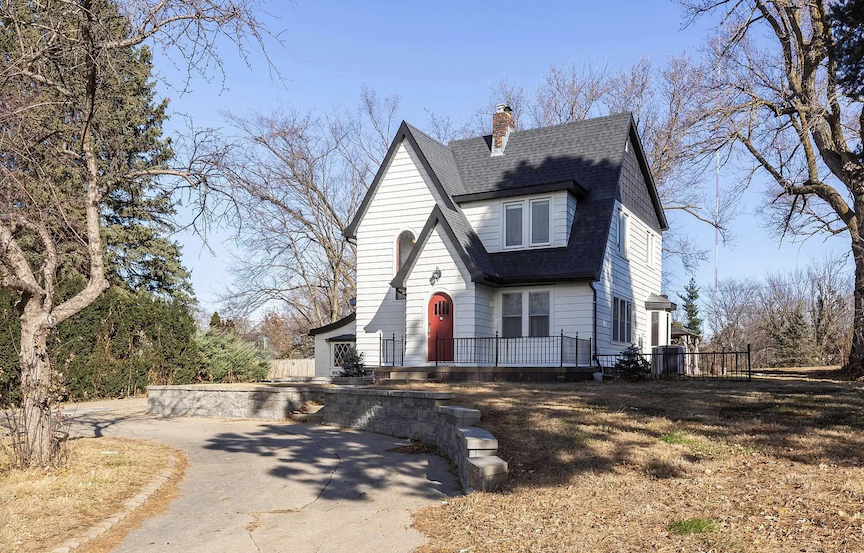

Just when I promised I’d go to bed earlier than 2:00, this drops in my inbox – o well, maybe tomorrow (of course it’s already tomorrow). This is a fabulous read that touches me in so many ways. I’m well familiar with OEA and all the other thrift stores in that vicinity. I was probably the “guy” you would see rummaging through stuff. My tastes were of the Victorian/Edwardian era, and I kept all the good stuff for myself, they never made it to my Antique shop. The linens and lace and handkerchiefs available were phenomenal, and were all handmade. I can only imagine the number of hours spent by lantern light on long winter’s nights making these items (try needle lace). I had to preserve as many as possible. And the Victorian dresses and hats were “to die for”. Unfortunately, my wife doesn’t have a 17 inch waste.
The Thurston mansion was quite large, and had a large glass domed conservatory on one side. The imparted visuals cause me to conjure up large cast iron fish tanks with fountains and large cast iron Wardian cases filled with plants and ferns. Supposedly, the house was moved near Creighton, 27th and California, rather than being demolished for the Hamilton. Quite a feat in and of itself. Thanks so much for this, I miss the days of the “hunt” for treasures of the past (although I possess way more than I can handle – but I still look 🙂
On a side note, I was perusing Ebay for Omaha buildings that have disappeared and ran across Mt St. Mary’s Seminary. I had never heard of it, but the Victorian building seemed eerily familiar. I must have seen it when I was very young since it was demolished in 1955. Turns out it was the original College of St Mary.
John, as always, thank you for this. A soul brother, through and through! You were rattling in those bins. I Must track the Thurston Mansion…
Love this article. All my childhood photos were taken at Matsuo . In the 40’s my parents opened a donut shop next to the Muse theater to the east and a furrier to the west. Dunk Donuts. They had to close and sell when my father was called back up to serve in the Korean War. After closing and selling he learned he was not eligible to serve because of health issues but by that time they had lost the business.
Thanks for the trip down memory lane.
This is amazing. So they owned the furrier also? What was it called? I found in my Muse theater investigation that there had been a furrier on the west side.
Just a little further up the (Farnam) street, KMTV was broadcasting. And on the corner of 25th Ave. sat The Ambassador Cafe and next to it, a bar called “Toys Lounge”. A watering hole for the Channel 3 imbibers !
Thank you for including these people. They were long haulers too! I have never heard of Toys Lounge. Interested in Raders folks too. They were in the thick of it, right next to The Hamilton. I appreciate it!
I always wanted to go Thrift Store shopping. but unfortunately, whenever I pulled up to a phone booth to find the store locations, the page with the thrift stores was always ripped out, so I never got to go 🙂 I feel so deprived and traumatized, wondering about all the treasures I might have missed. Has anyone else experienced this pain? (Sorry, as I re-read your story, I couldn’t resist the temptation to remark about the yellow pages. I can’t say for sure, but that might be why there are no longer any phone booths around. 🙂
You tease! but I about cried—-already guilt ridden about my teenage self.
We were all teenagers once…….enough said 🙂 Take solace in the fact that you have at least one person who reads your writings multiple times. It’s due to your style of writing that reminds me of thee old movies from the golden era where you have the protagonist in an off screen dialogue racing through a myriad off thoughts and questions flowing through her mind as she tries to make some semblance of order and meaning of them, only to discover more questions – while on screen action images are flashed of what comprises these thoughts resulting in a “mystery quest” to be solved. i love this style of writing, and you have nailed it. The only way that’s achieved and perfected so well is through life experiences. Who knew that removing a “yellow page” would help make a really good writer 🙂 O, if your wondering if I ever removed a “yellow page”, before I can volunteer a “truthful” answer, I need to check out the statute of limitations 🙂 Would love to write more, but I have a LARGE Victorian dinner at our house this Sat. I have been polishing silver for over a week now and still have much cleaning to do. Please, no more stories until Sunday 🙂
Great article. Thank you for your intense and thorough investigation. I am unable to stop reading till the end.
As you soon as you said the building was designed by Latenser, I had to look to see if the City of Omaha had the original architectural plans. Lo and behold, here they are.
https://landmark.cityofomaha.org/images/pdf/Microfilm_Drawings/1920-05-11_Sweet-Store-Bldg_2402-Farnam.pdf
You are amazing!!! Thank you so much!!
This is fabulous – thank you. Love the leaded/stained glass windows on the west side – early art deco – and the leaded glass transoms above the windows (long boarded over). Same with the globe lights between the corbels up top. They seemed to have lasted until the 1950’s. If I’m reading this correctly, it appears that everything on the roof sloped to the middle where there was a drain that emptied inside and down. Not something I would call ideal for Nebraska weather, especially with the freeze/thaw cycles in winter. Wonder if there were a lot of roof leaks.
I could swear I used to go to The Smoke Pit before it got it’s own place. In the early ’70s it was on the first floor of a hotel. I believe it was when it was in the Delmar and on the Northwest corner of 24th & Farnam. Me and my buddies would close a bar on South 24th and go down there to get some great food. Yes, it was open past 1am. I don’t think it got it’s own place till after 1978 because I was then living in Colorado and was surprised by it’s success.
Hello Bill, That does it—I need to do a story just focused on the Smoke Pit! I’ve wanted to for a while but you’ve motivated me. Thank you for your clues! Here’s what I’ve found so far. Joseph Dubinsky opened the Smoke Pit in 1961. It was at 2239 Farnam Street but oddly their slogan was “24th and Farnam.” 2239 Farnam never was used as a postal address before or after. I could not tie it to the Delmar Hotel with any actual proof but I have no reason to doubt you. When I google search that address it places the location quite a bit further east of 24th and Farnam, as you might guess. But addresses are often weird and can’t really be nailed down. The first Smoke Pit was described as a place some folks might “not feel comfortable in the neighborhood at night” and that the clientele came “from varied backgrounds—both social and economic” but that the barbecue brought them together. There was said to be a brick oven at the front of the restaurant with a glass door that allowed customers to see their meat cooking as they placed their orders at the counter. “Surroundings are humble. Large wooden tables and chairs, plus a few booths, can seat about 50 patrons.” There was a wooden buffet at one end of the room and the floor was said to be inlaid tiles “popular decades ago in meat markets and pharmacies.” I am praying that meant yummy linoleum! They were open 5 pm to 3 am. It wasn’t until 1982 that the Smoke Pit moved to 230 South 25th Street—then called “25th and Farnam.” Dubinsky and wife, Kim, owned the Smoke Pit until they closed. Thank you so much for your comment and for making me dig further!
I will add to the comments about the Smoke Pit, as I was surprised that it’s original location was not mentioned in the body of the story.
I’ve been away from Omaha for decades, but distinctly recall the original location being in a building on the south side of Farnam, east of 24th. It was our usual stop on the way home from the Howard St Tavern on weekend nights. Good BBQ, but a truly frightening bathroom located in the dark basement down a flight of rickety stairs. You truly felt you’d been somewhere when you made it back up. I always suspected some did not…
Thanks again for all the excellent stories.
Thank you so much. I could see, hear and feel the rickety stairs to the basement vibe from your description. Love it. It must’ve been in that building that got taken down for the federal reserve property. Perhaps it was in the building that the original Powers Pharmacy was in, seen in the earlier a photo? That would make sense, because the article mentioned the floor was commonly seen in an old pharmacy. Please share any more clues as they come up. I never knew it was down the street. Thanks!
I think you may be right.
I recall that our little band of idiots were sorely disappointed when the “new” Smoke Pit opened up and across Farnam, as all the seedy charm had been replaced with bright lights and non-threatening plumbing. Sacrilege to west Omaha kids trying to keep it real, man.
speaking of prostitutes, right across Paxton Ct from your 2561 Douglas building, there used to be a phone booth next to that apartment building. At the time, I worked for US West in the pay phone dept. We’d often get reports that the light in the booth was burned out. What was happening was that the ‘girls’ would hang out in the lighted booth at night to display their wares to motorists driving by. The apartment manager disapproved, and would break the lamp. Then the girls would call in a report. Wash, rinse, repeat.
Speaking of the Smoke Pit, indeed it was originally at the SE corner of 24th & Farnam. Near the original Nebraska Furniture location.
The phone booth! I forgot about their essential significance to this equation. Thank you!
You can see a brief shot of The Flame in this film: https://youtu.be/MXrnBv76_nE
My mother was one of the retired teachers who worked at the OEA thrift store. My father also became a volunteer there in his retirement. Most of the items at the store were donated by teachers. I still have some antique classic books from ‘the store’, vintage designer hats and gloves of all colors. The retired teachers who worked there cared about their customers whether assisting a cross dresser coordinate an outfit or making sure that the man who needed dress shoes for a new job got a good pair. We all had a giggle when someone broke into ‘the store’ and stole some clothing. He left his old clothes behind including his wallet in the pants pocket. It was an interesting place filled with heart.
I can’t believe they tore down the Delmar. That block was like walking into the cover of a Tom Waits album. And look at what a magnificent structure they replaced it with, lol.
Fantastic article!! Ernest Sweet was my Grandmother Addie’s brother. I knew that he had been in real estate, but didn’t realize it was to this extent. I have a better photo of Ernest and Mae, if you want a digital copy. Do you happen to know where Sweet’s additions 1 and 2 were? Thanks for putting this info out there-well done!
Hello Dianne, I would, indeed, like a better photo for this article or anything else you’d be willing to share. The Ernest Sweet addition is up in North Omaha. It borders North 24th on the east and Wayne Lowden Avenue on the west. The houses are on Larimore Avenue and also 24th. The Ernest Sweet second addition is along that Howard Street area I’ve written about before. https://myomahaobsession.com/2017/01/23/mysteries-of-omaha-2226-howard-street/ This time, it’s South 24th, to the east between Dewey Avenue and Howard Street. Really interesting places. The website’s email address is myomahaobsession@yahoo.com. Thanks so much!